Project Overview
When the Detroit Historical Museum reopened in November 2012, it was met with rave reviews and over 3,000 visitors on opening day – well above the usual 200 to 500 that typically visit in a day.
Key to the success of the museum’s reinvention are five new galleries – America’s Motor City, Detroit: The Arsenal of Democracy, Allesee Gallery of Culture, Doorway to Freedom and Innovation Detroit – which showcase the cultural, business and entertainment history of the city. Linking these very different exhibit areas – 70% of which are new or greatly expanded – are the graphics and interpretive signage Gene designed.
Detroit: The Arsenal of Democracy
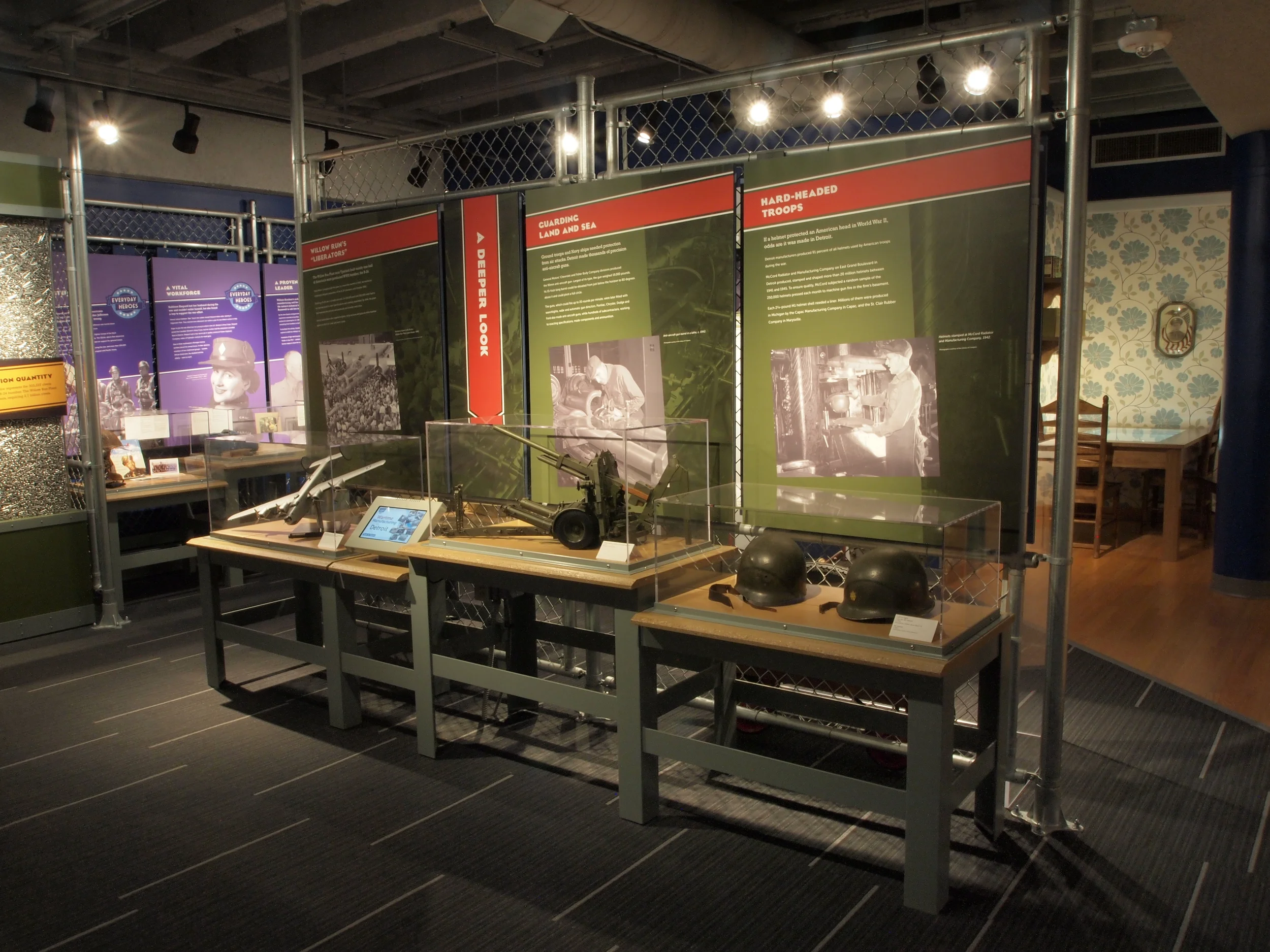
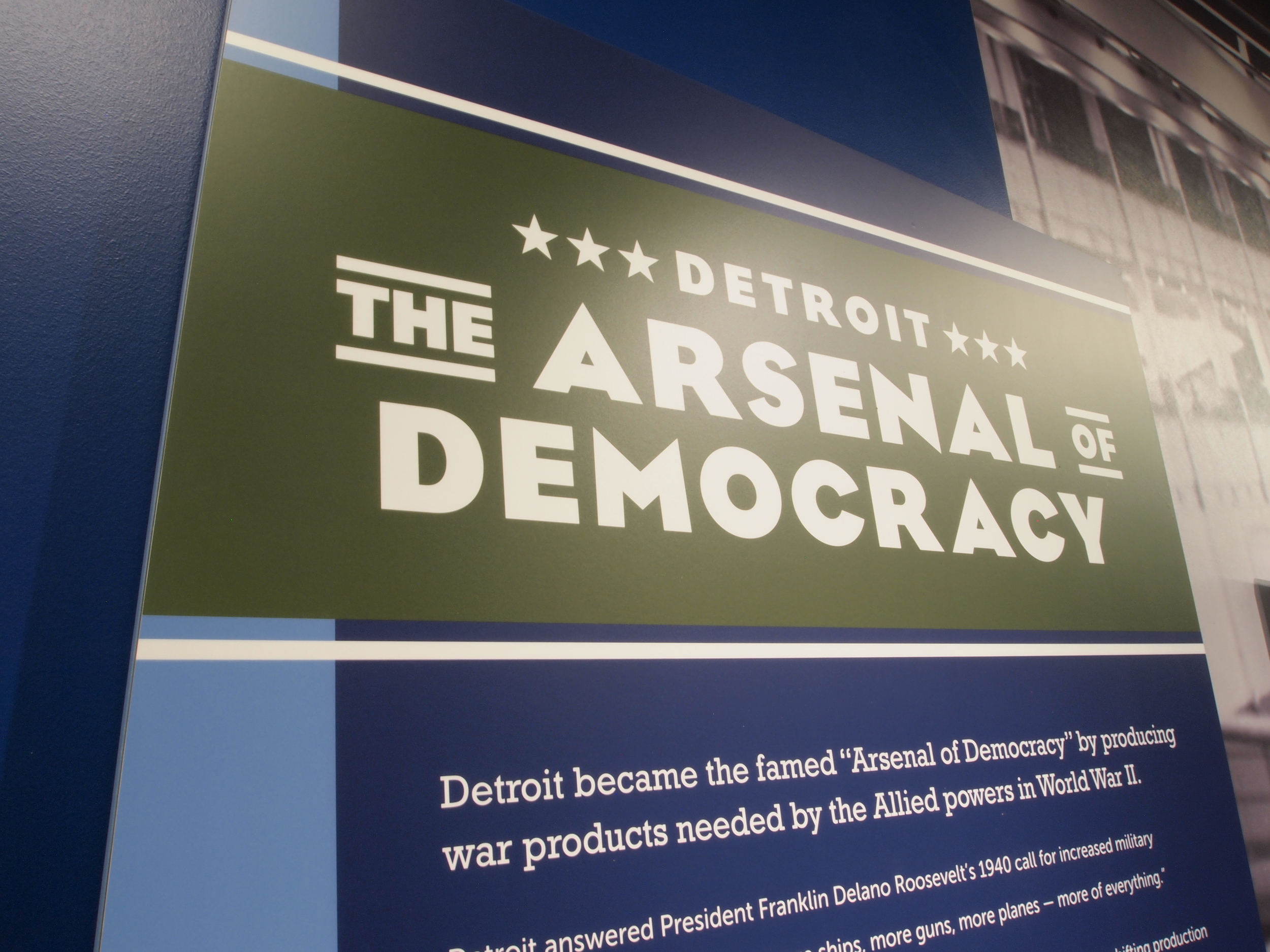
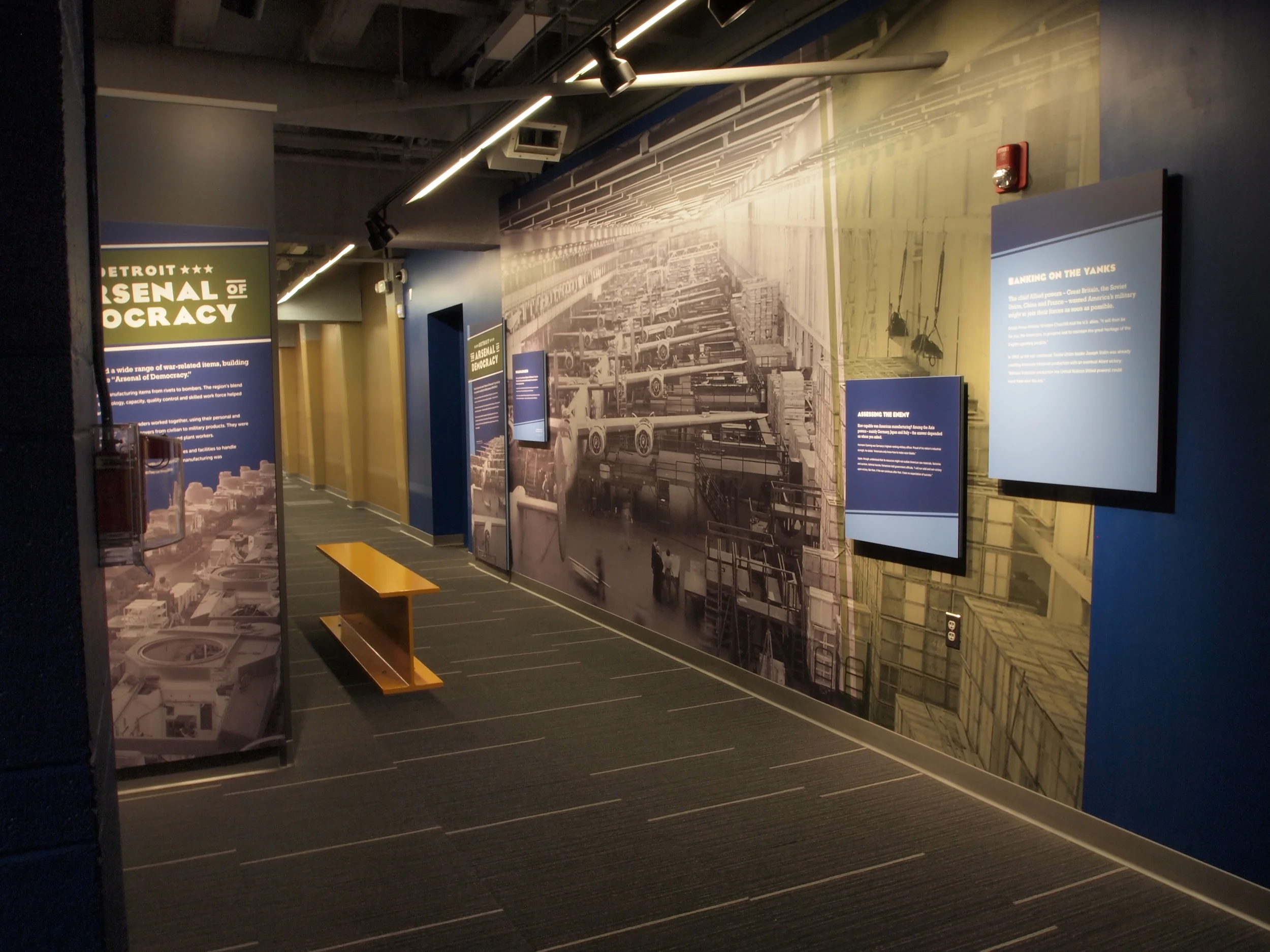
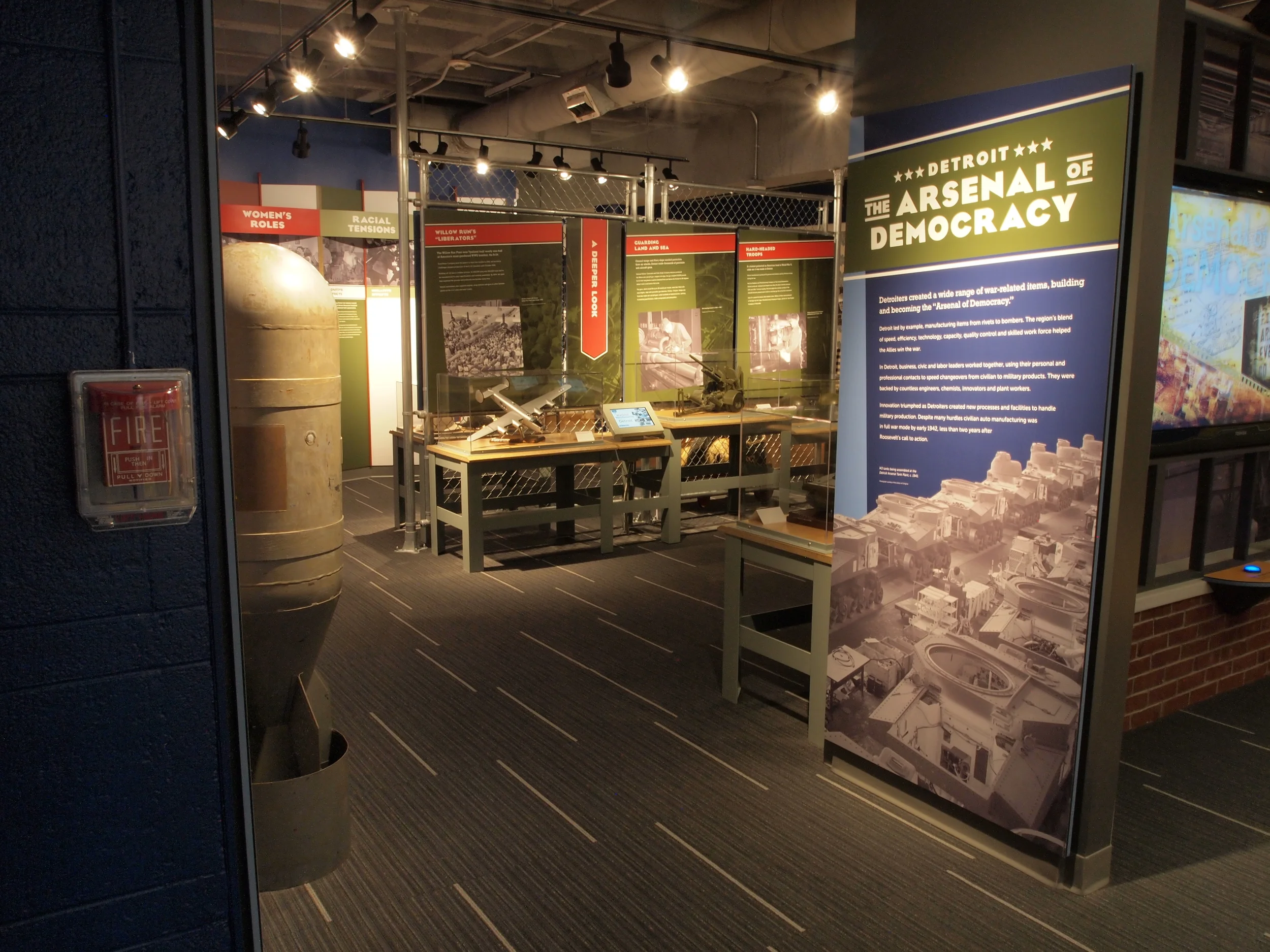
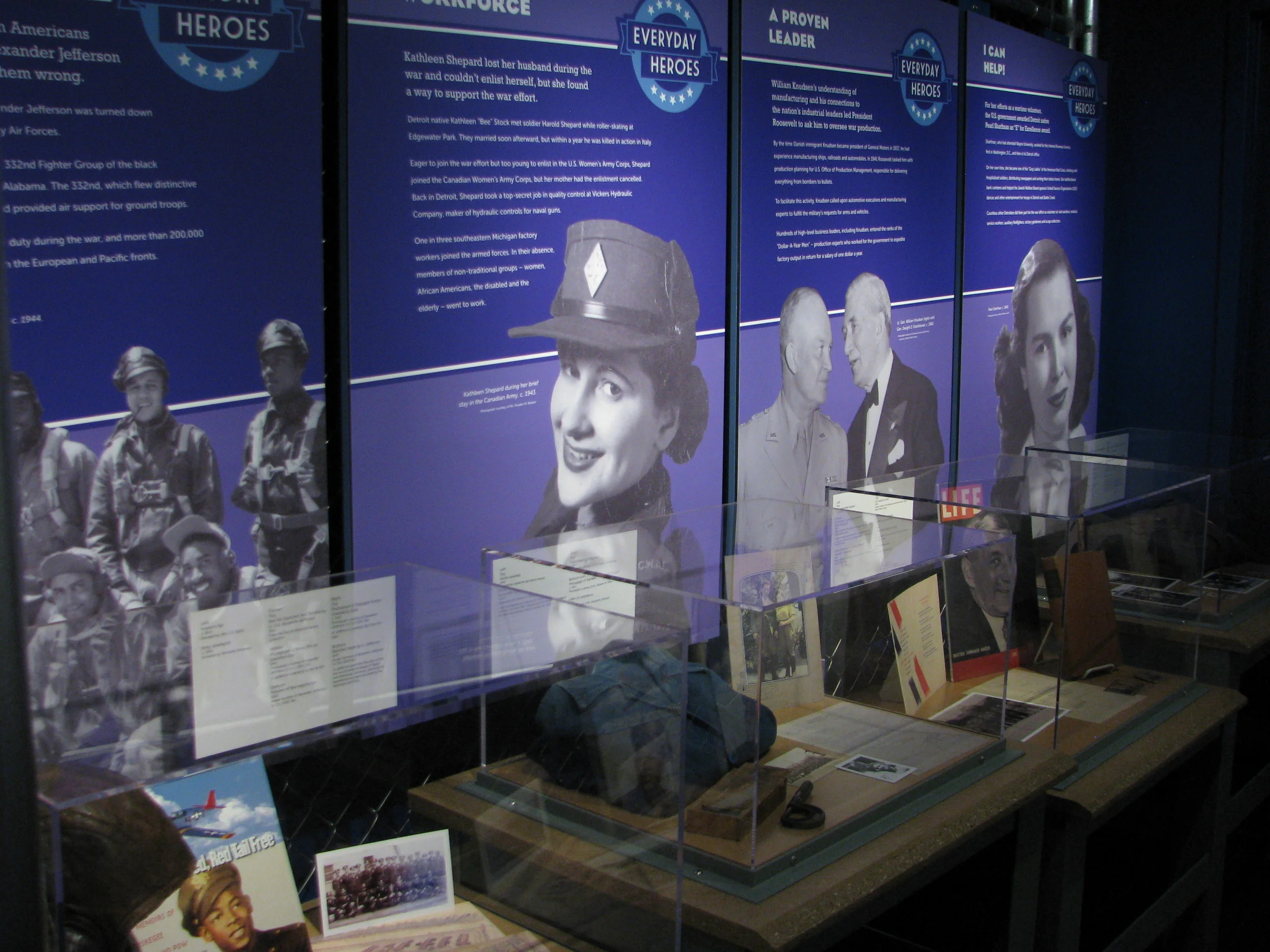


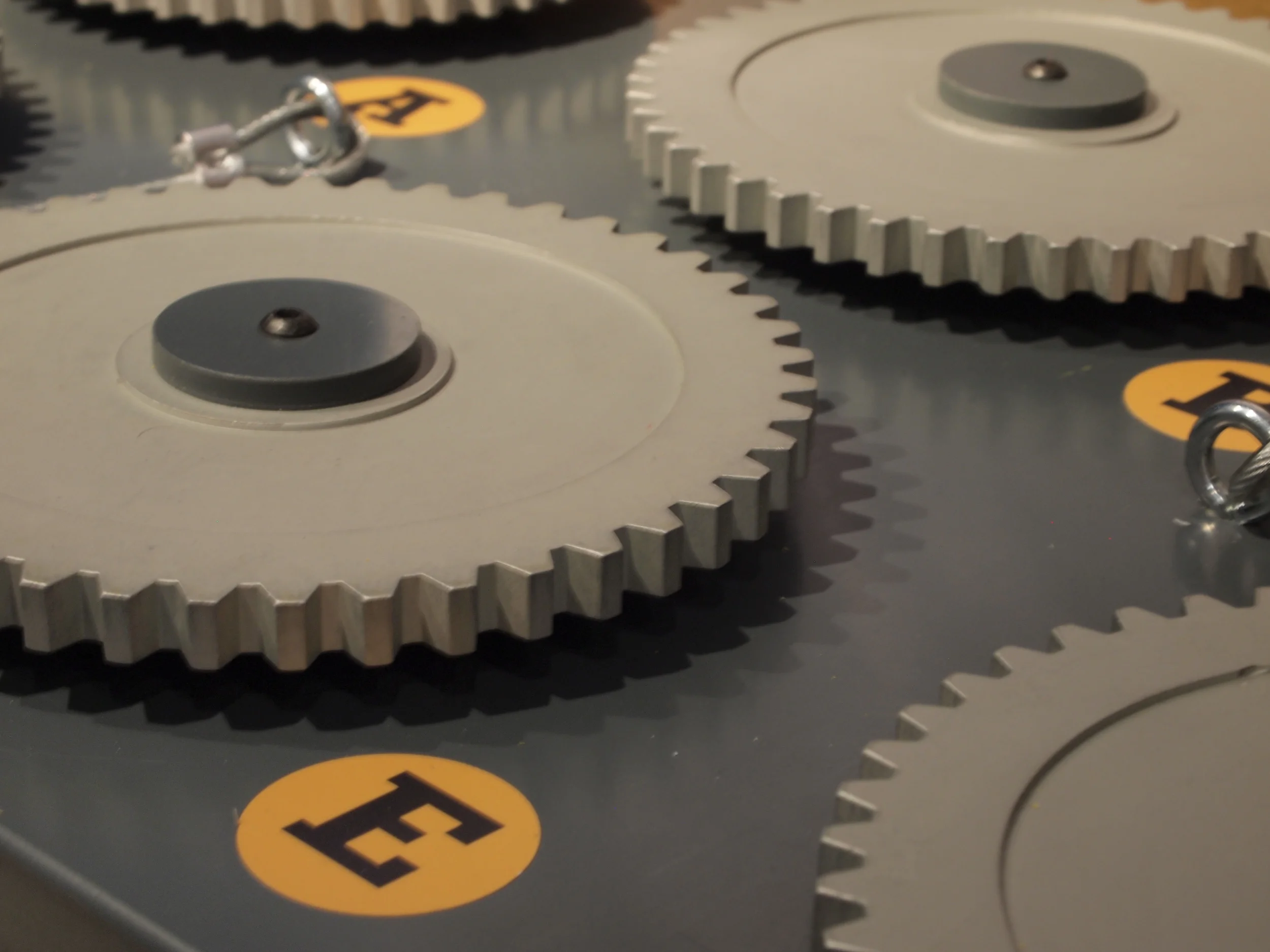
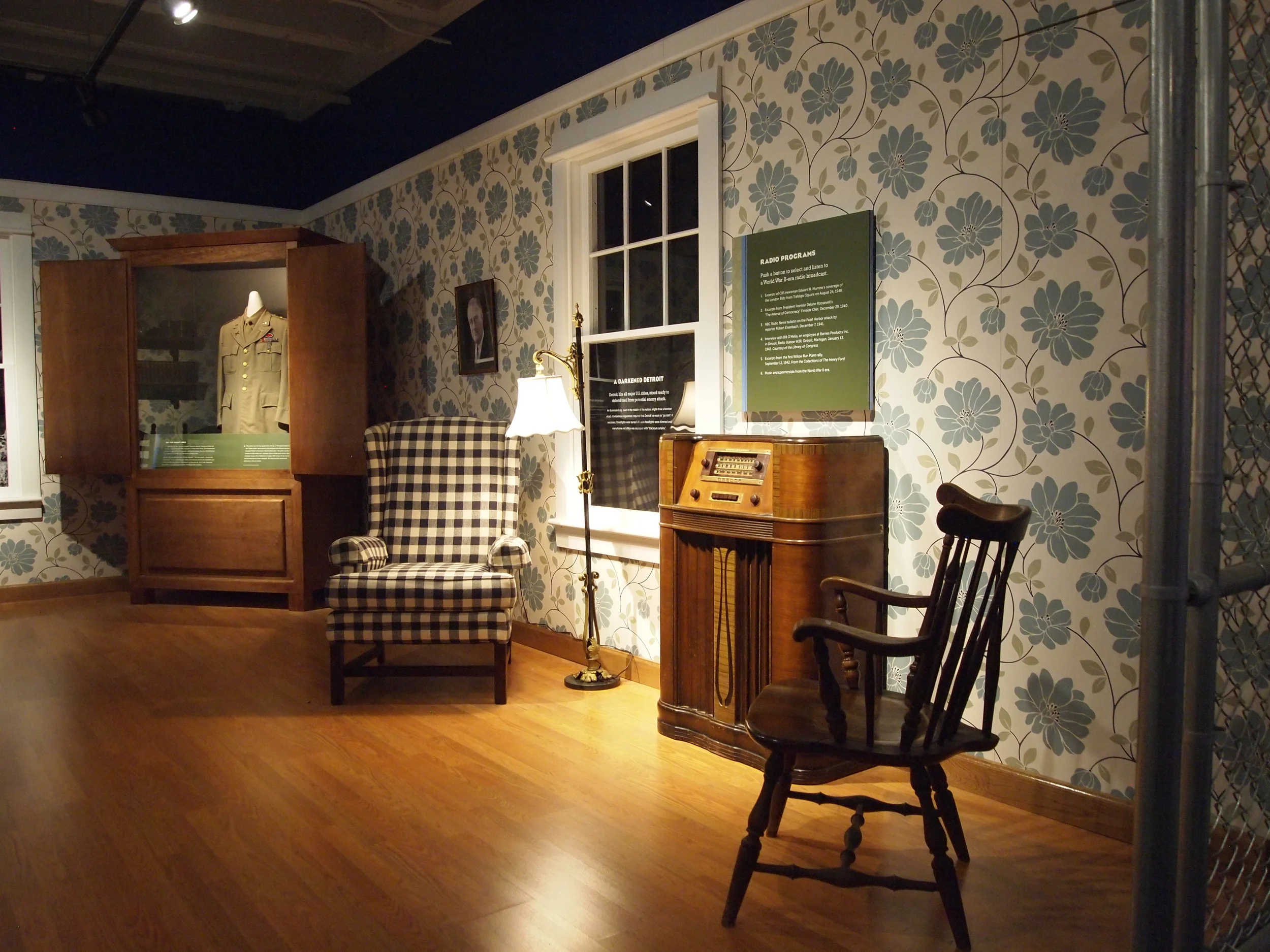


From ground transportation to B-24s, Detroit’s manufacturing capabilities made it central to the United States efforts in World War II.
Employing 40,000 people, the Willow Run bomber plant was the largest factory in the world, churning out one complete B-24 Liberator every hour. By the end of the war, the men and women who worked at Willow Run had manufactured 8,576 B-24s. Along the way they used 2.7 billion rivets.
But bombers weren’t Detroit’s only contribution to the war effort. Ammunition, communication equipment, vehicles, weapons, protective gear, tools and field goods were all made in Detroit. So much war manufacturing was done there that by the middle of the war Detroiters were responsible for producing one-third of all the materials used by the armed forces.
The Arsenal of Democracy gallery – which takes its name from President Franklin D. Roosevelt’s request that the nation become “an arsenal of democracy” shows how a city turned its skilled labor force and manufacturing expertise into making “The Yanks” a force to be reckoned with and with helping the Allies win the war.
In creating the graphic design for the gallery, Gene looked to poster artwork of the 1930s and 1940s for inspiration. Murals, interpretive panels and labels for the artifacts in this gallery are all designed to evoke the feeling of unity and patriotism felt on “The Homefront.”
“War and its impact lie at the very heart of the Historical Museum’s ‘Arsenal of Democracy’ exhibit, another national story in which Detroit played an outsized role. This well-organized exhibit strikes a great balance between detail and brevity. A three-minute video at the start takes us from the late 1930s into the ’40s, when a Detroit decimated by the Depression turned into a wartime boomtown virtually overnight.” – Michael H. Hodges, The Detroit News
America’s Motor City

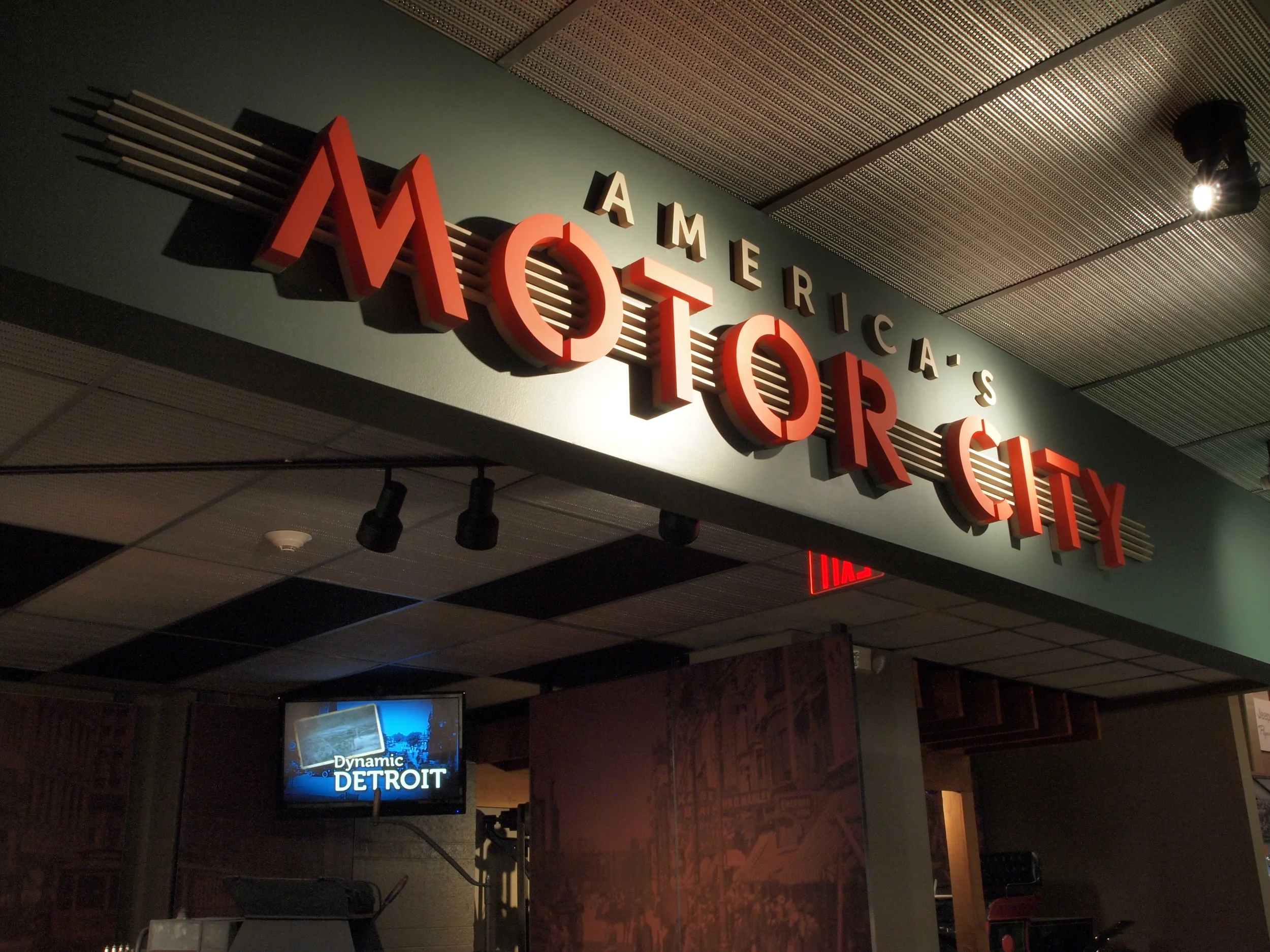
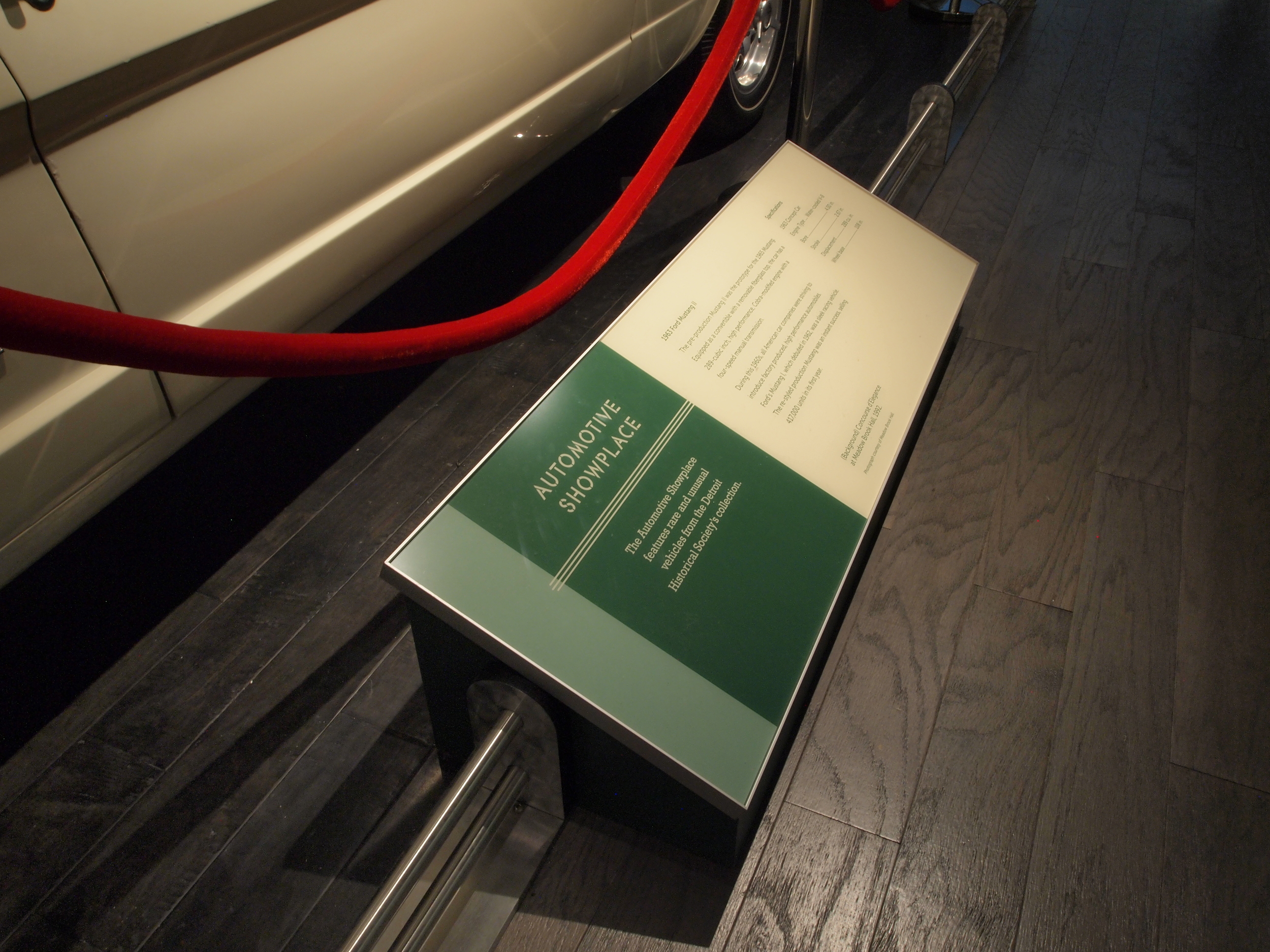
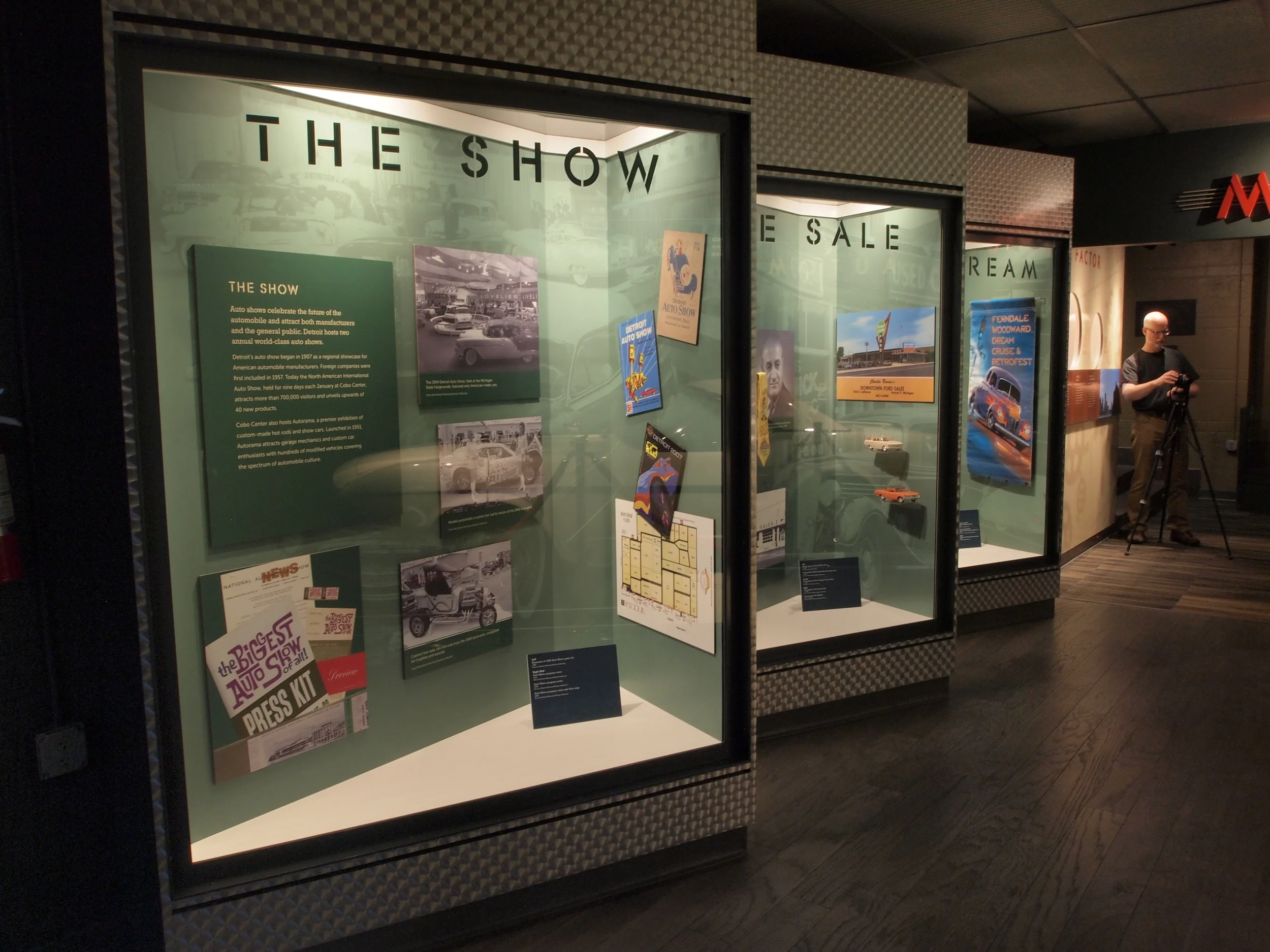


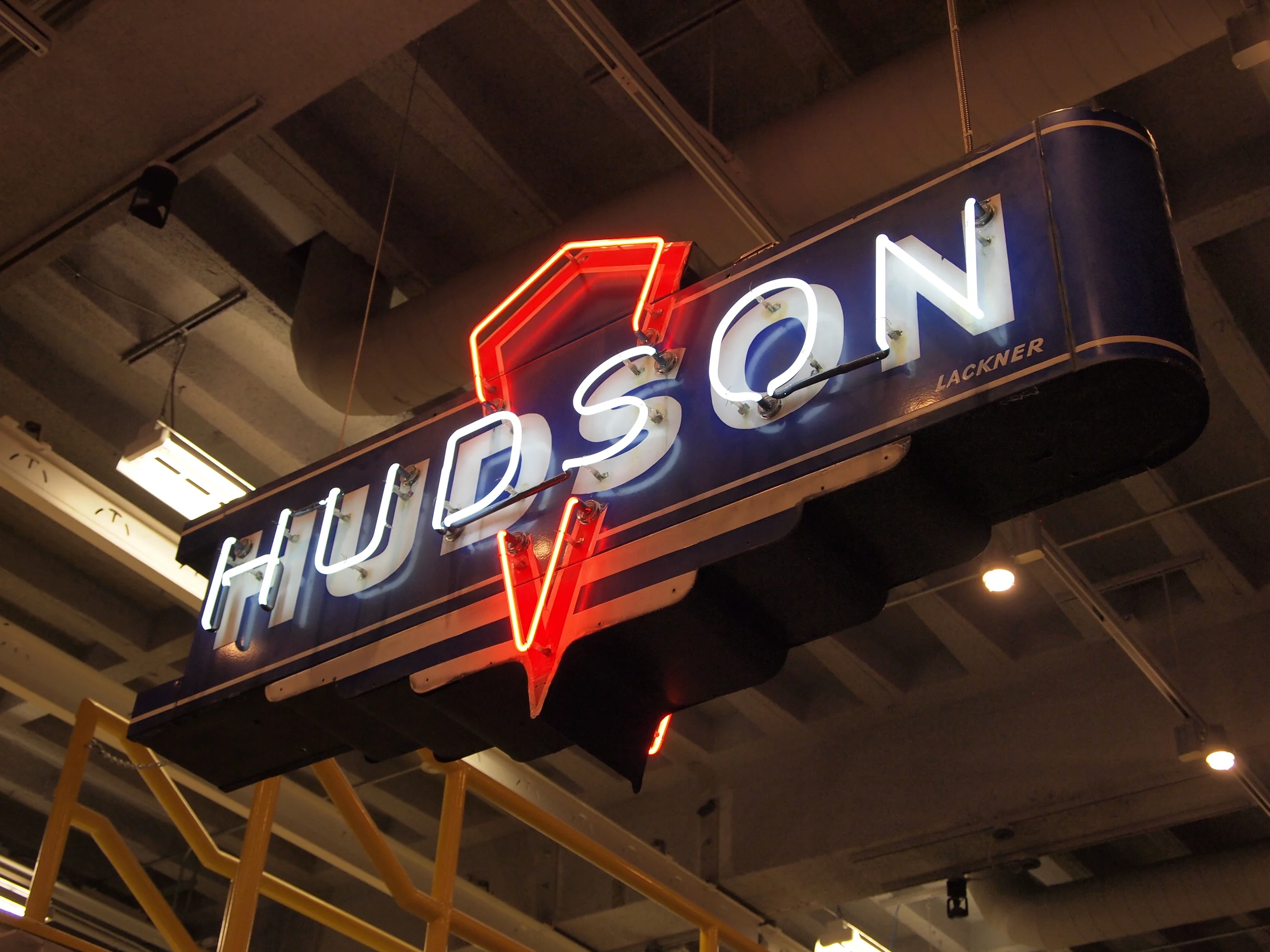
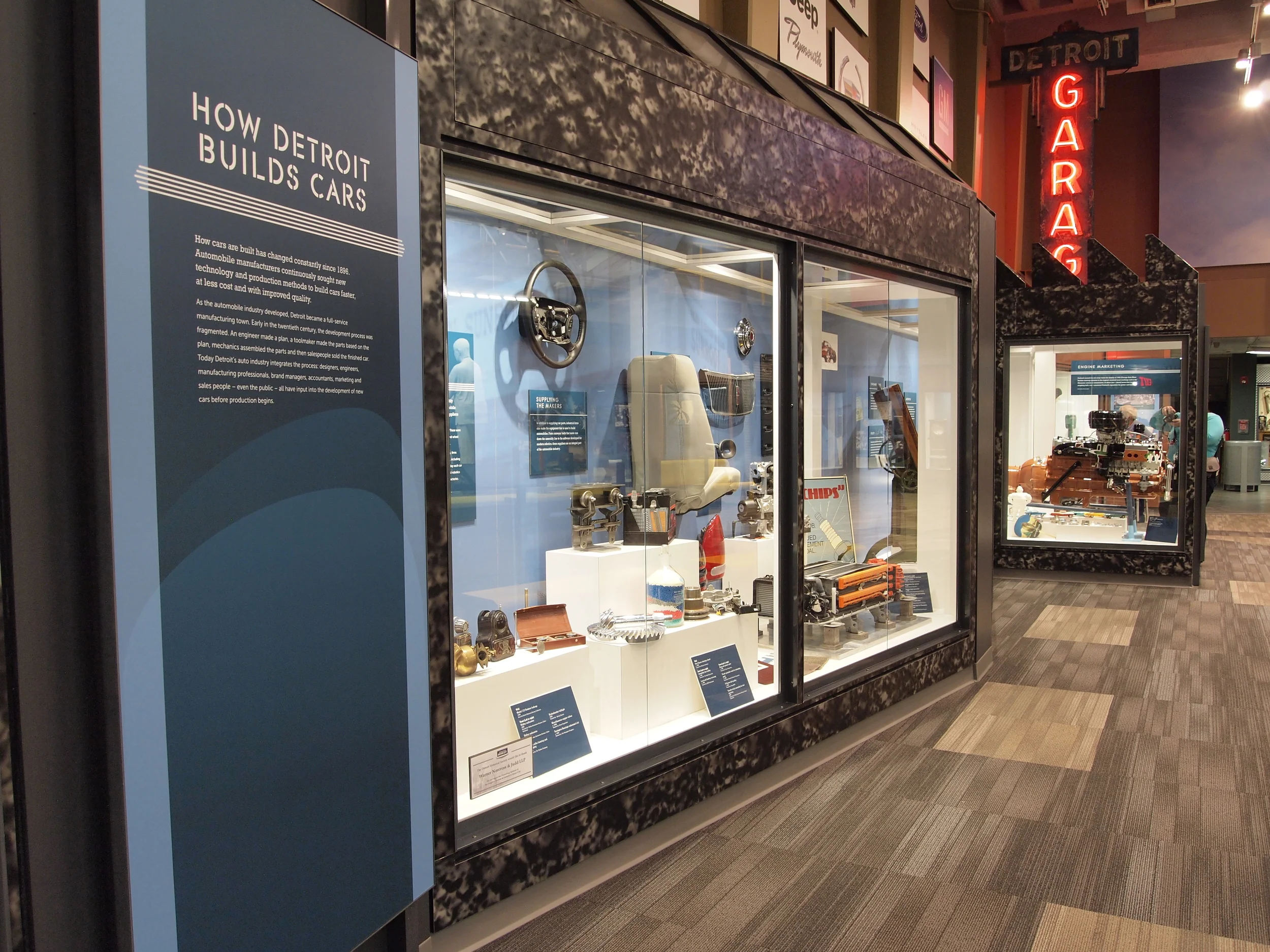
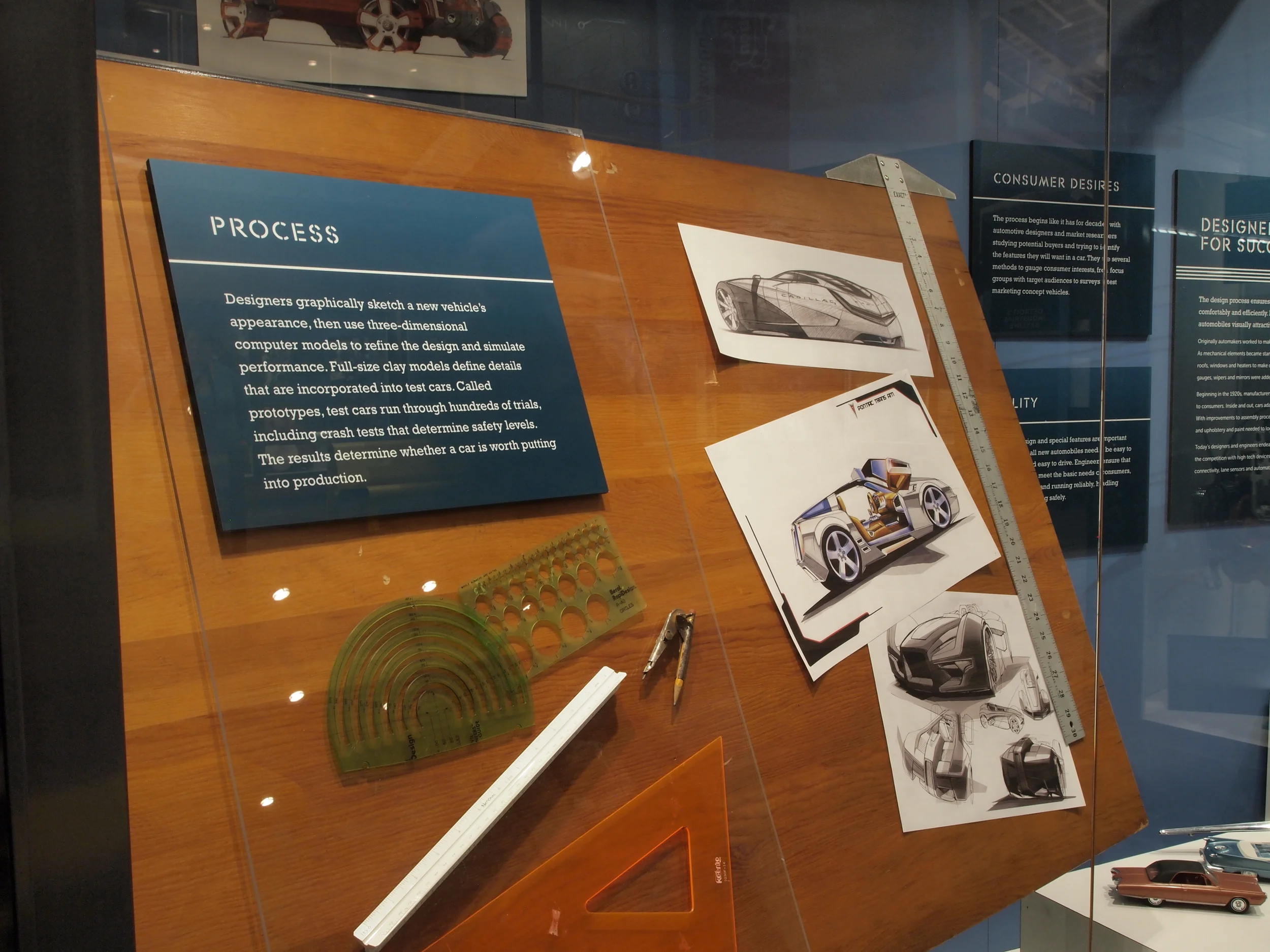

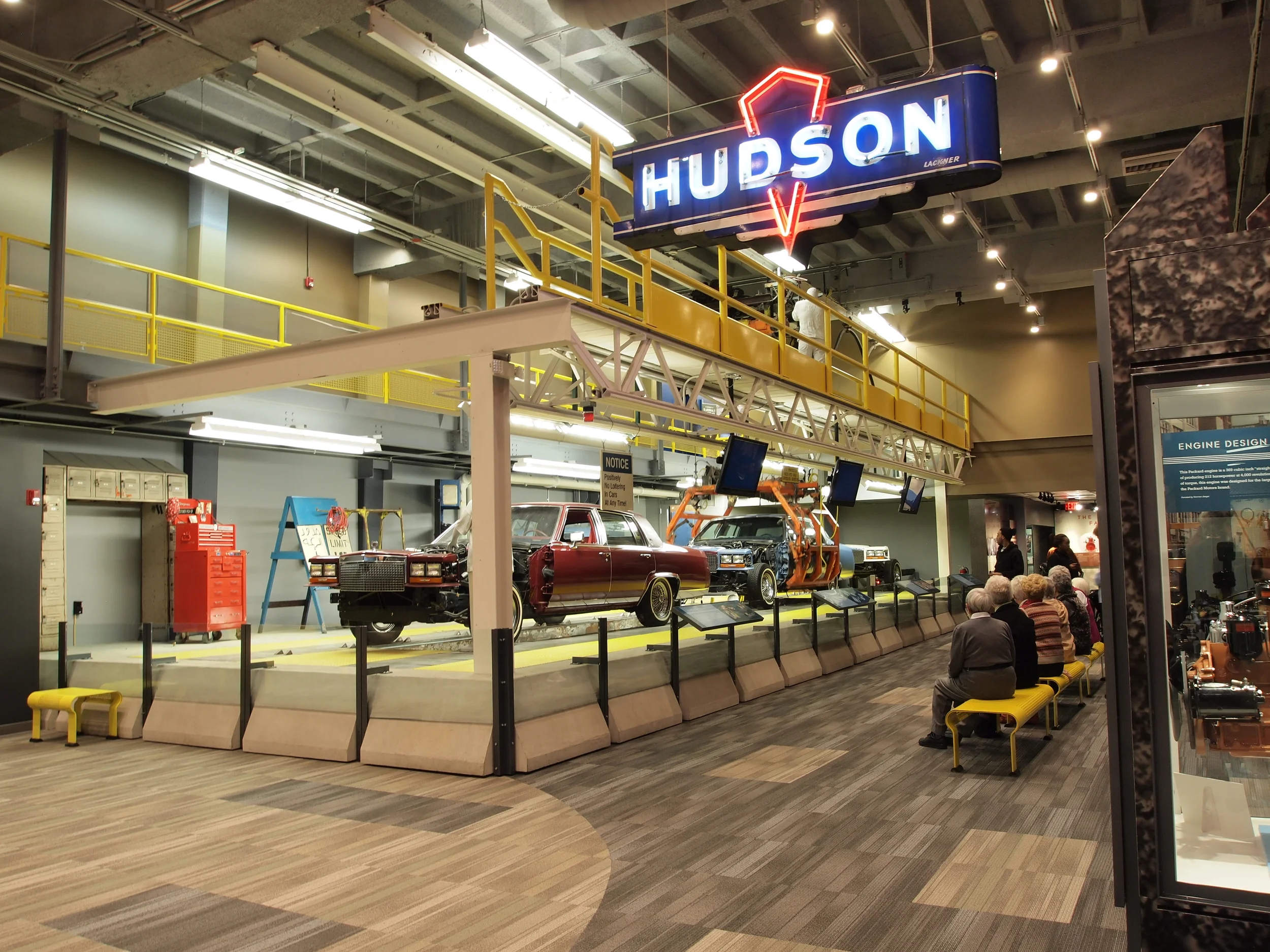
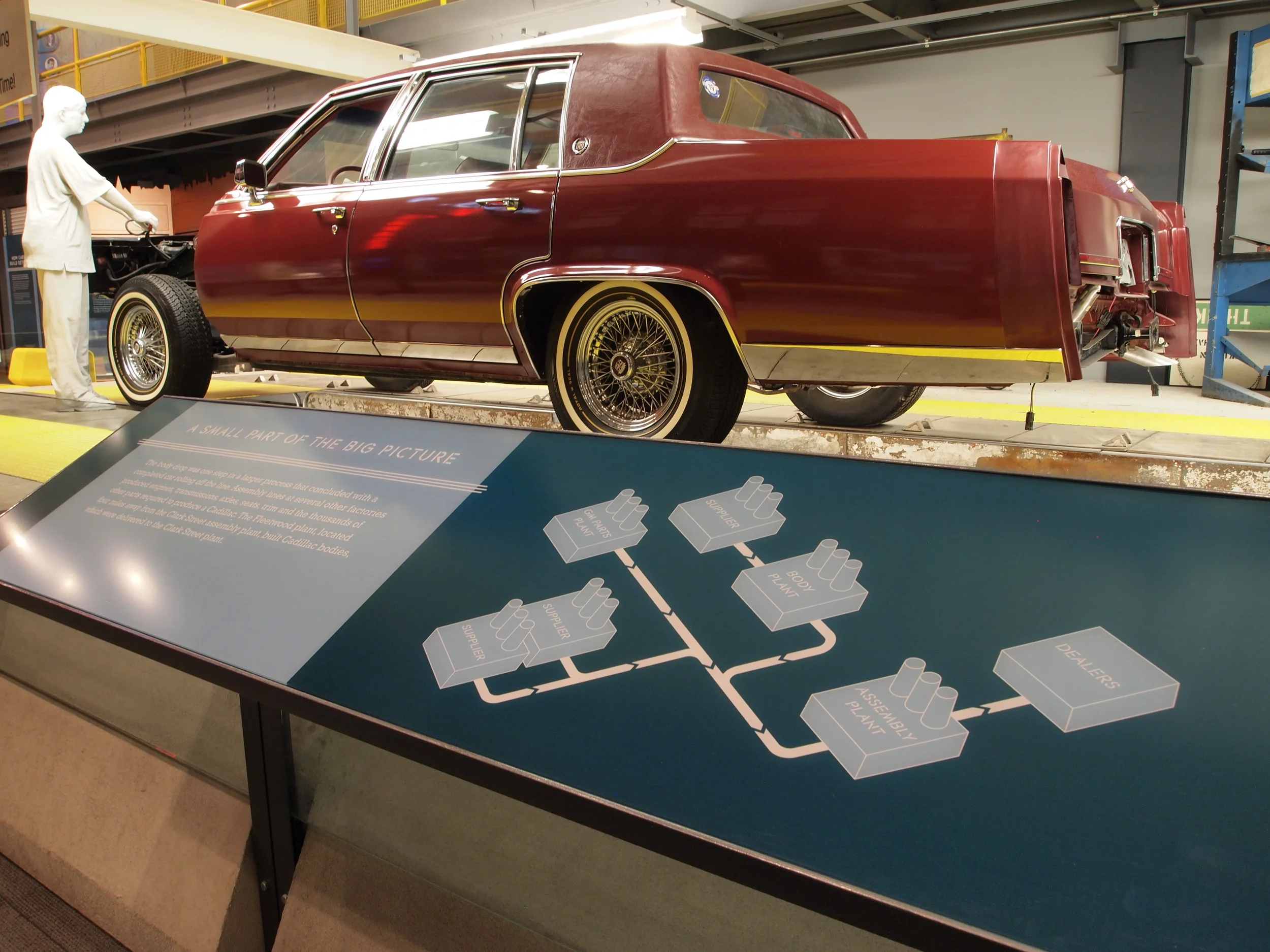
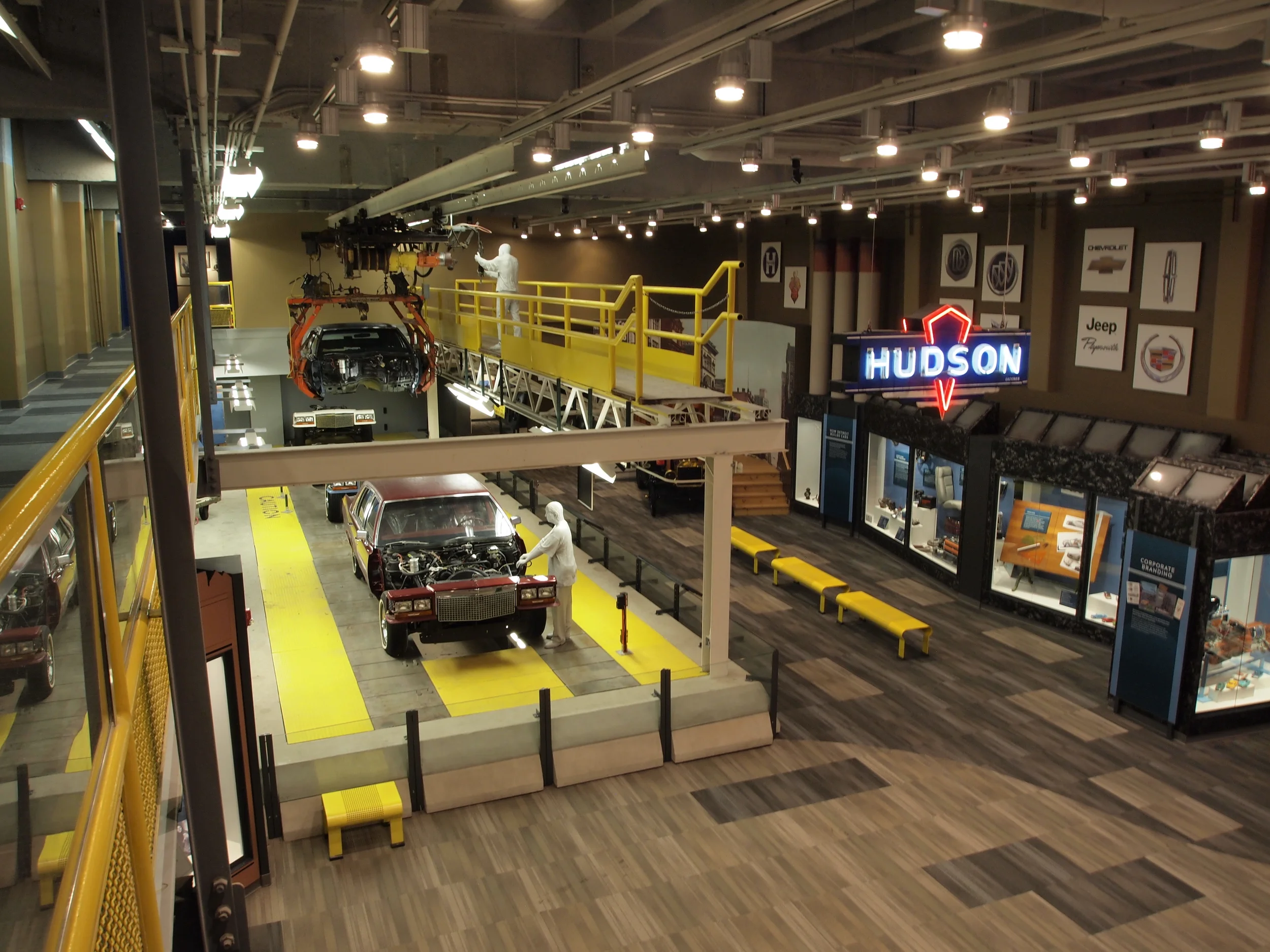


Did Detroit make cars or did cars make Detroit? In the early Twentieth Century Detroit became the leading producer of the automobile. That didn’t happen by accident. It took a special mix of entrepreneurs, inventors, manufacturers, natural resources and capital to fuel Detroit’s transformation into “Motor City.”
Visitors to the America’s Motor City exhibit are enthralled by the interactive body drop installed in the gallery. Reclaimed from a retired assembly line – the key to Detroit’s dominance in auto manufacturing for many years – this exhibit shows visitors how auto workers combine a chassis and body assembly.
Through the gallery’s educational exhibits, museum visitors are taken from the early days of auto manufacturing – when Henry Ford was offering cars in any color the customer wanted as long as that was black – to the muscle cars of the 60s and beyond. Plus visitors can see a few car name plates that are just – well history.
Gene’s work contributes to the success of this gallery through the use of color and changes in the graphic design approach. Just as Detroit evolved as a city, the auto industry evolved from merely providing transportation to creating a car culture that is unmatched in any other country. Similarly, Gene’s graphic program evolves as visitors move through the gallery, changing to delineate the different gallery areas. He successfully uses graphics, type and color to provide the visitor with a sense of Detroit’s evolution as a modern manufacturing city.
Innovation Detroit
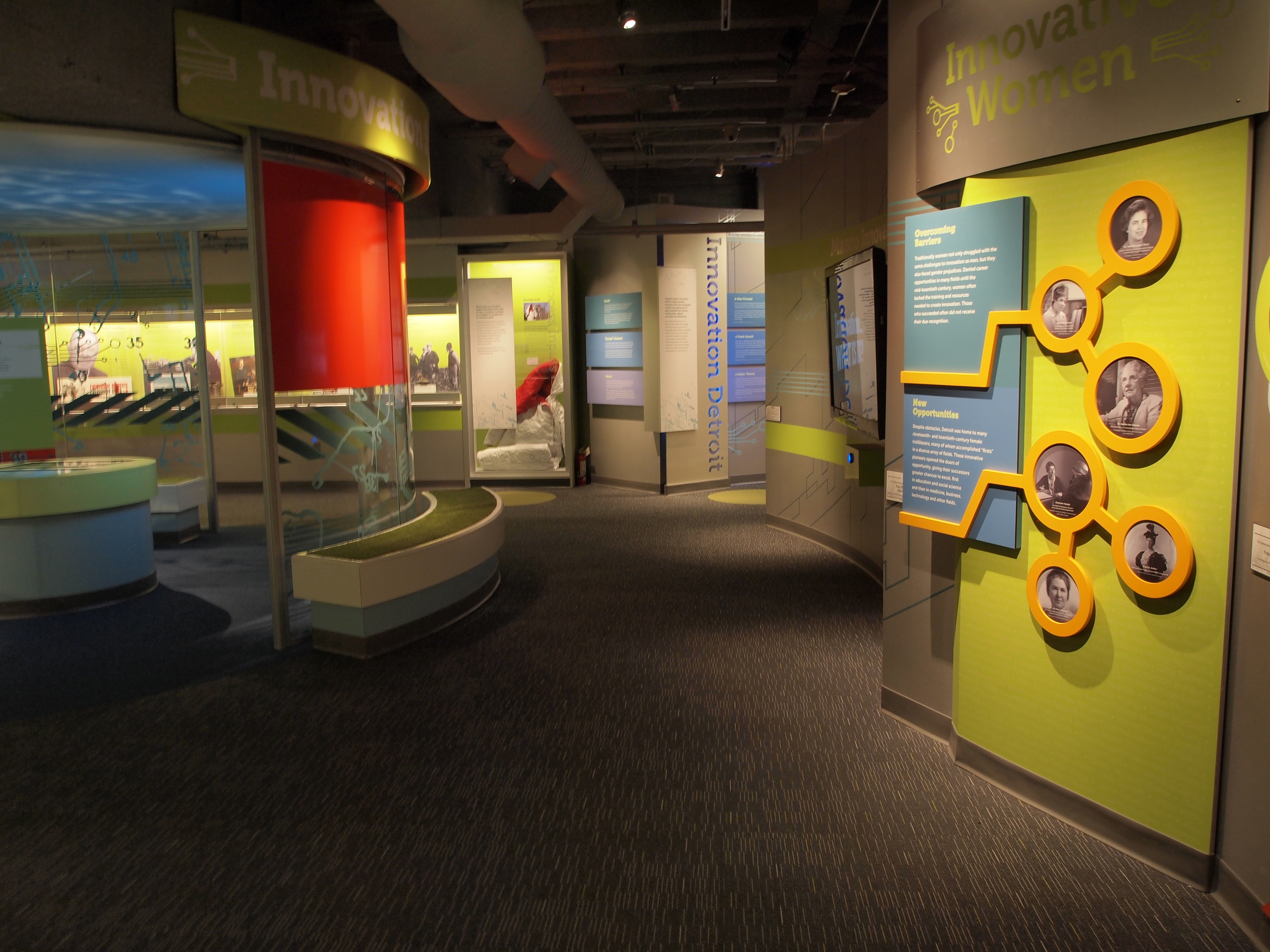
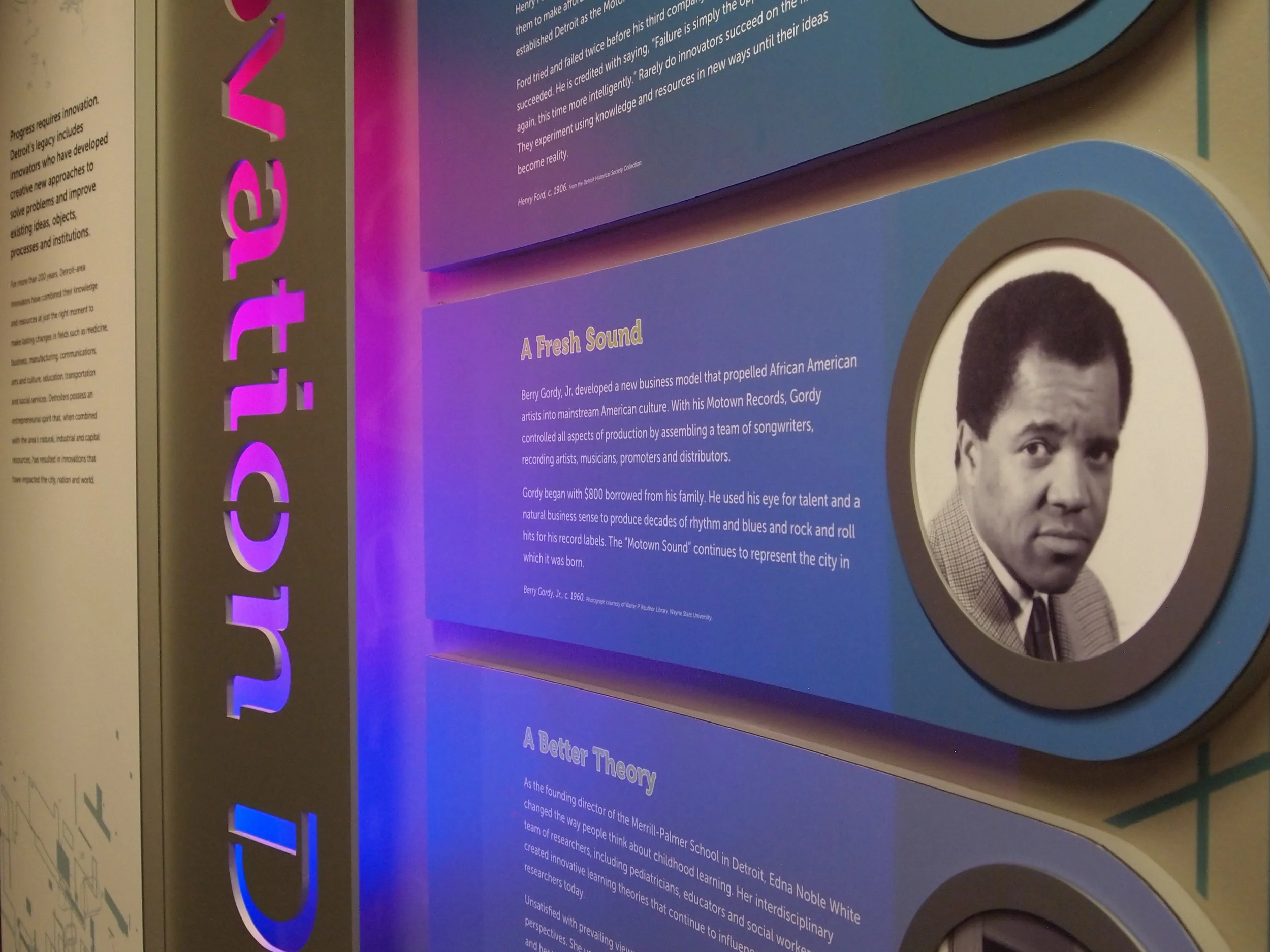
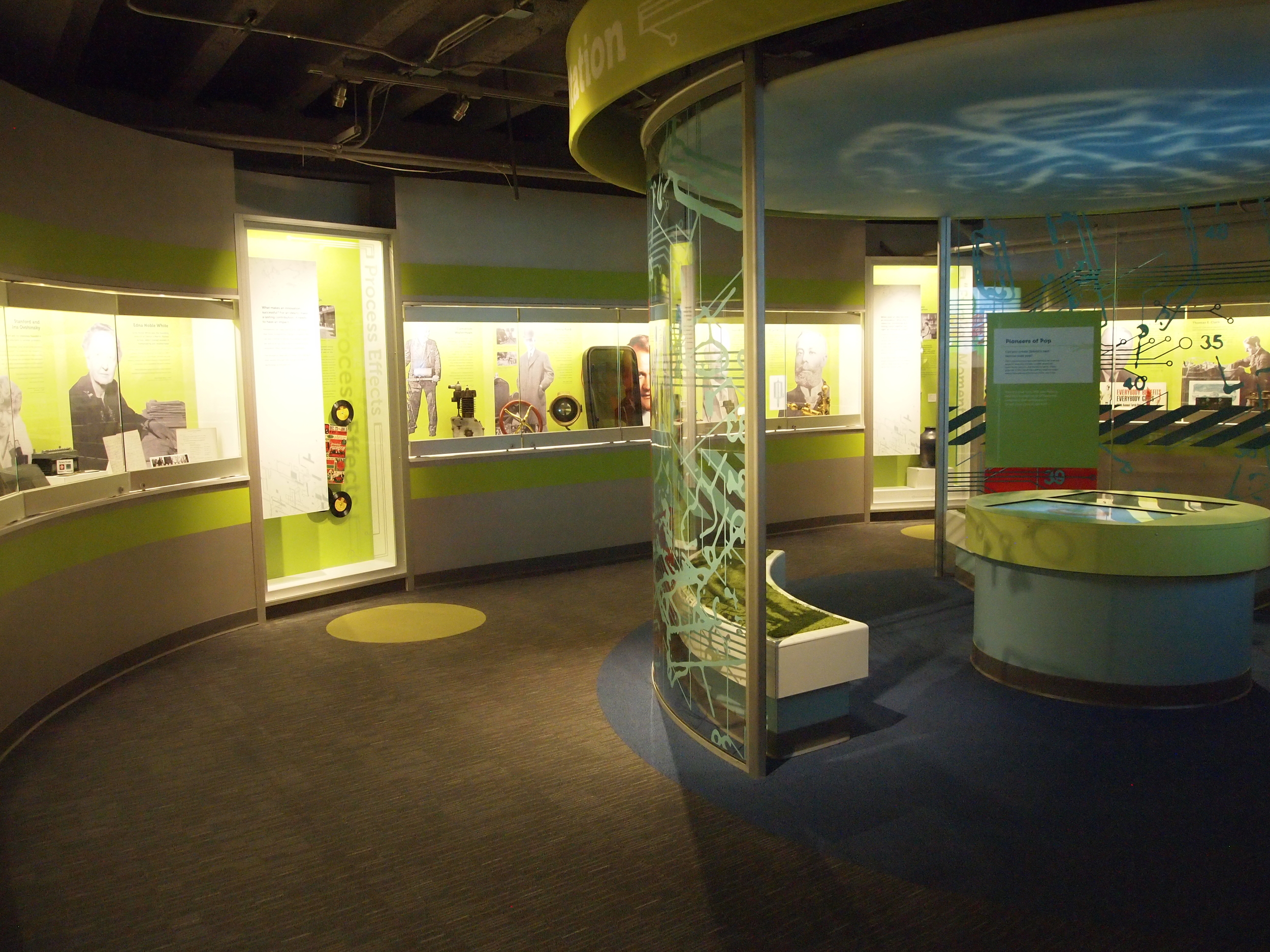
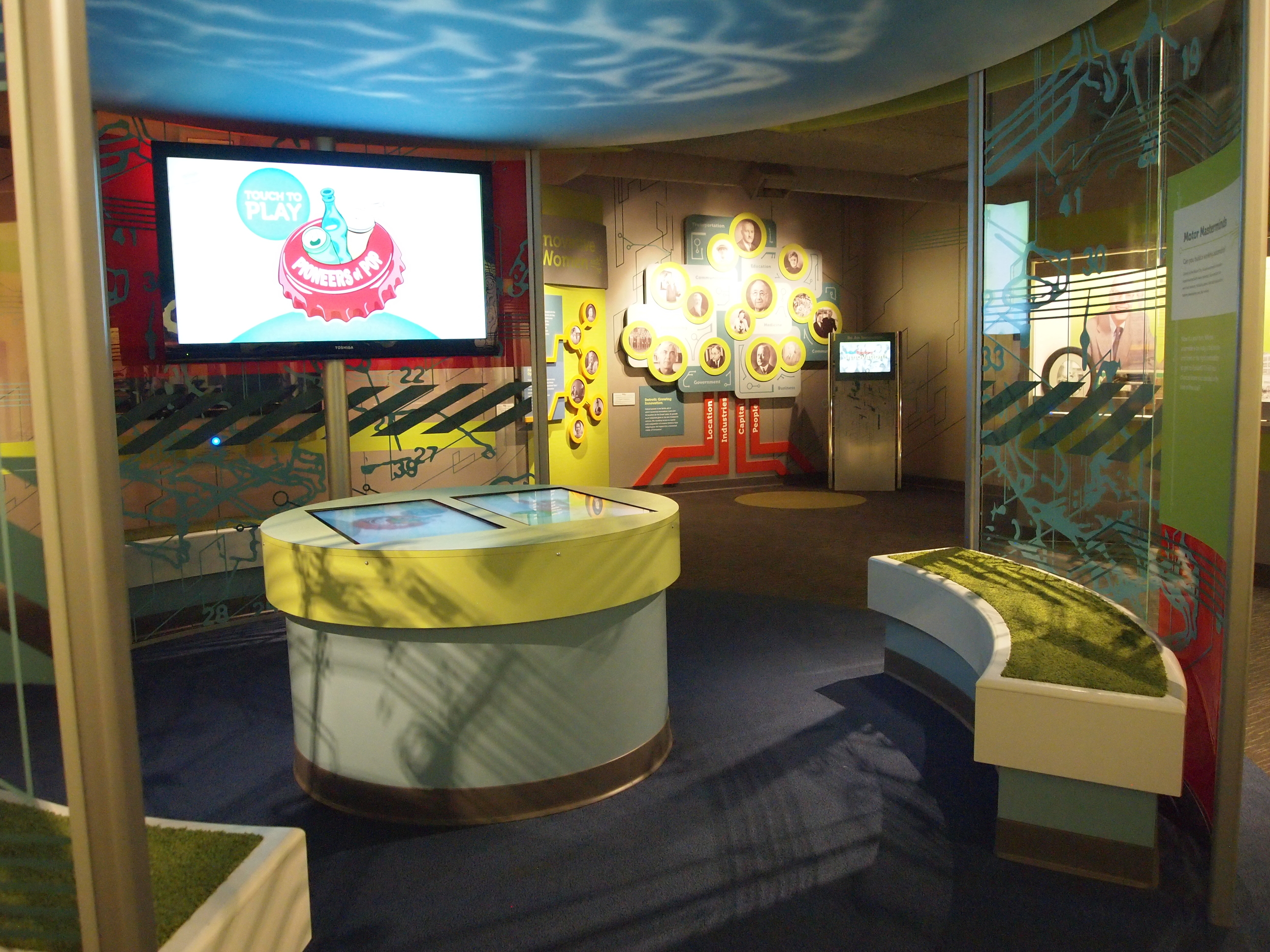
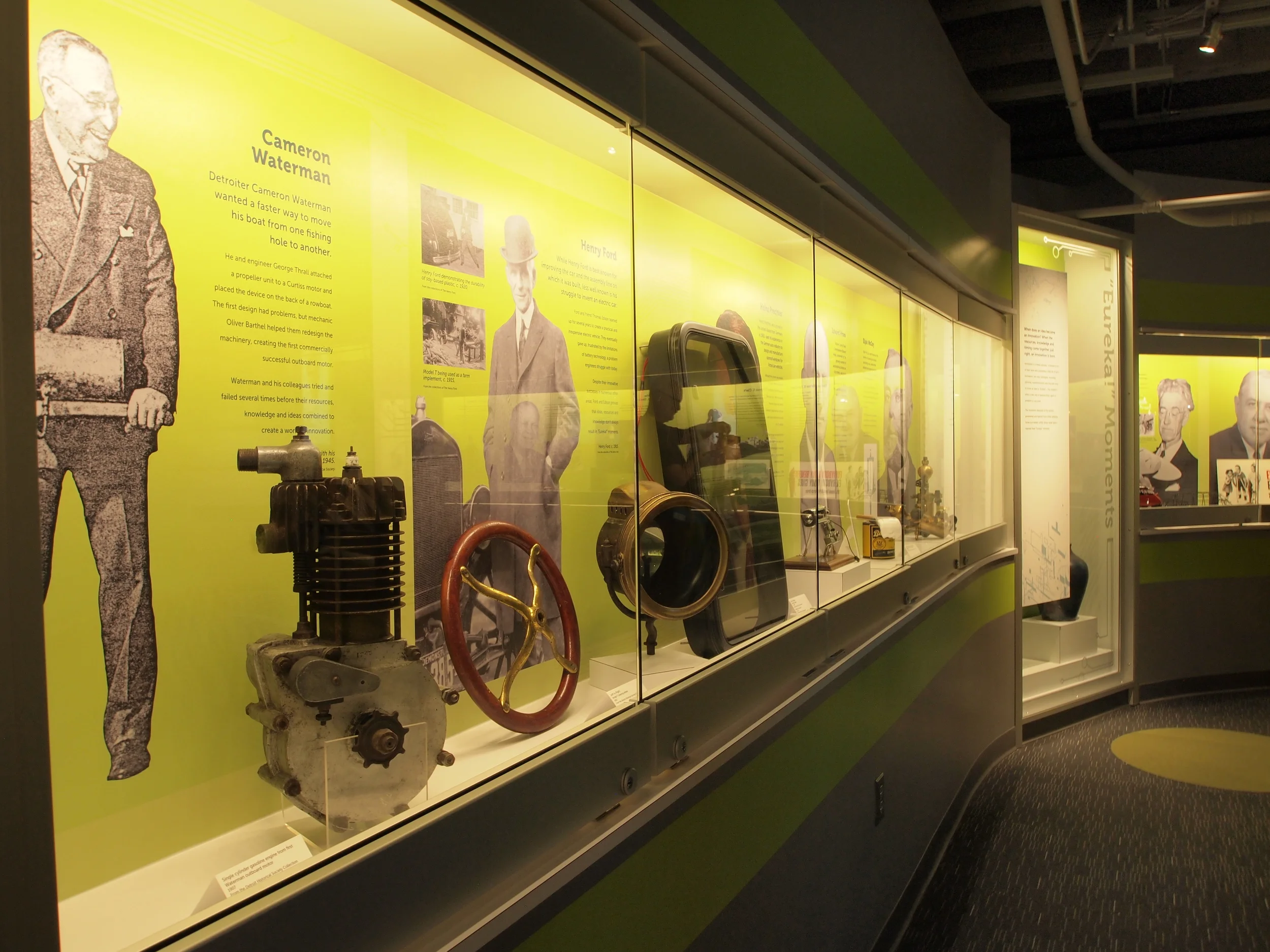
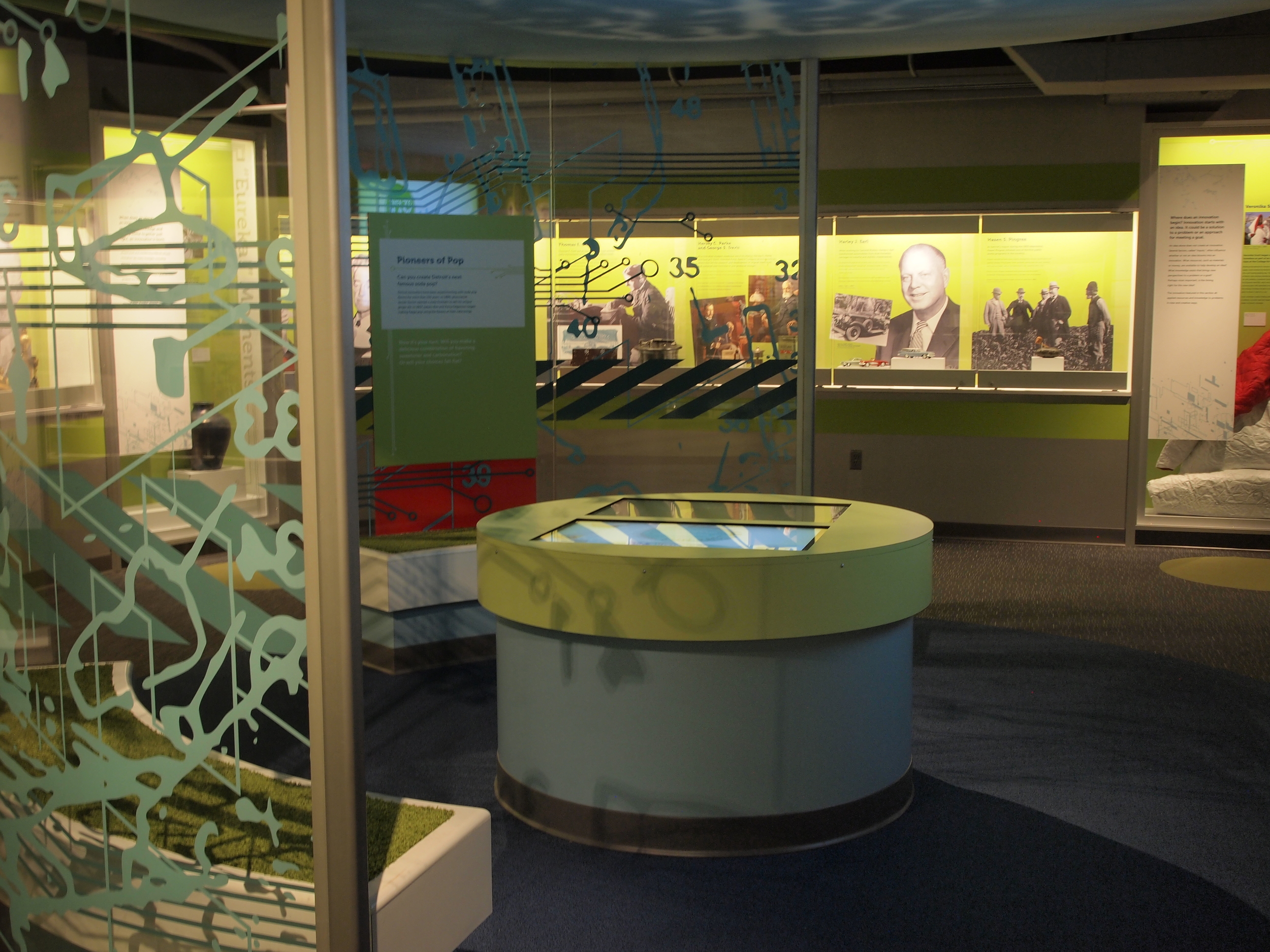
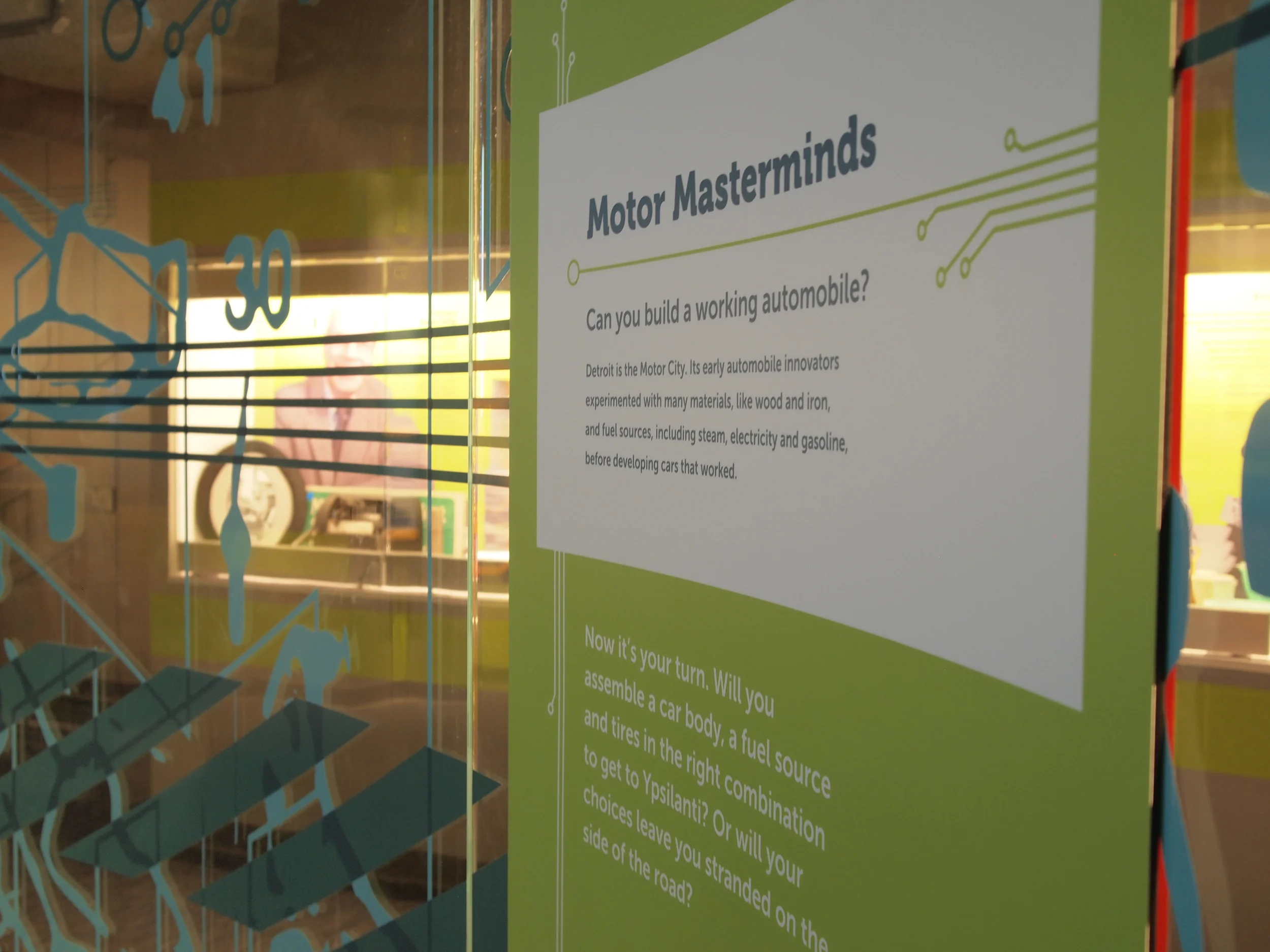
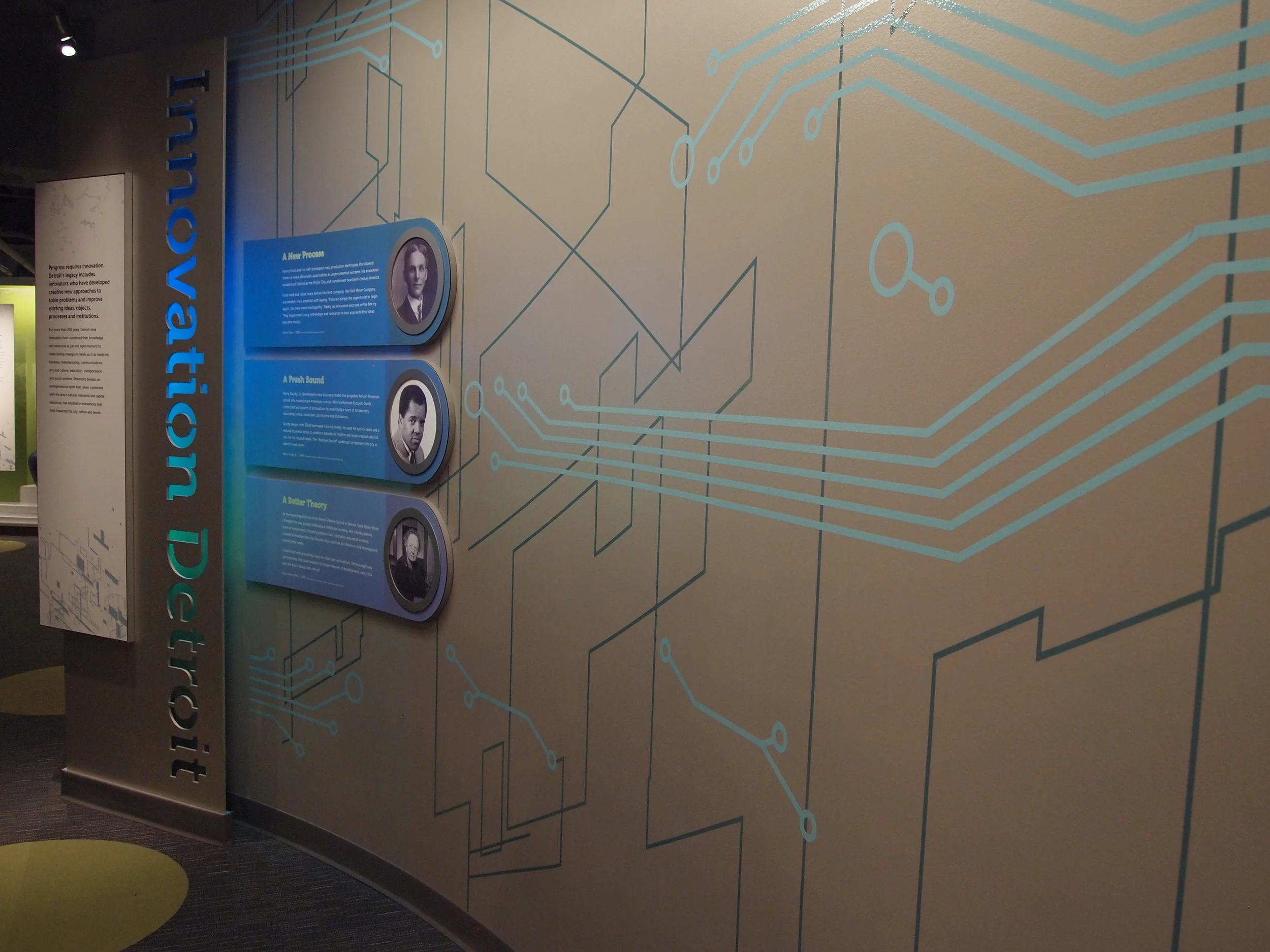
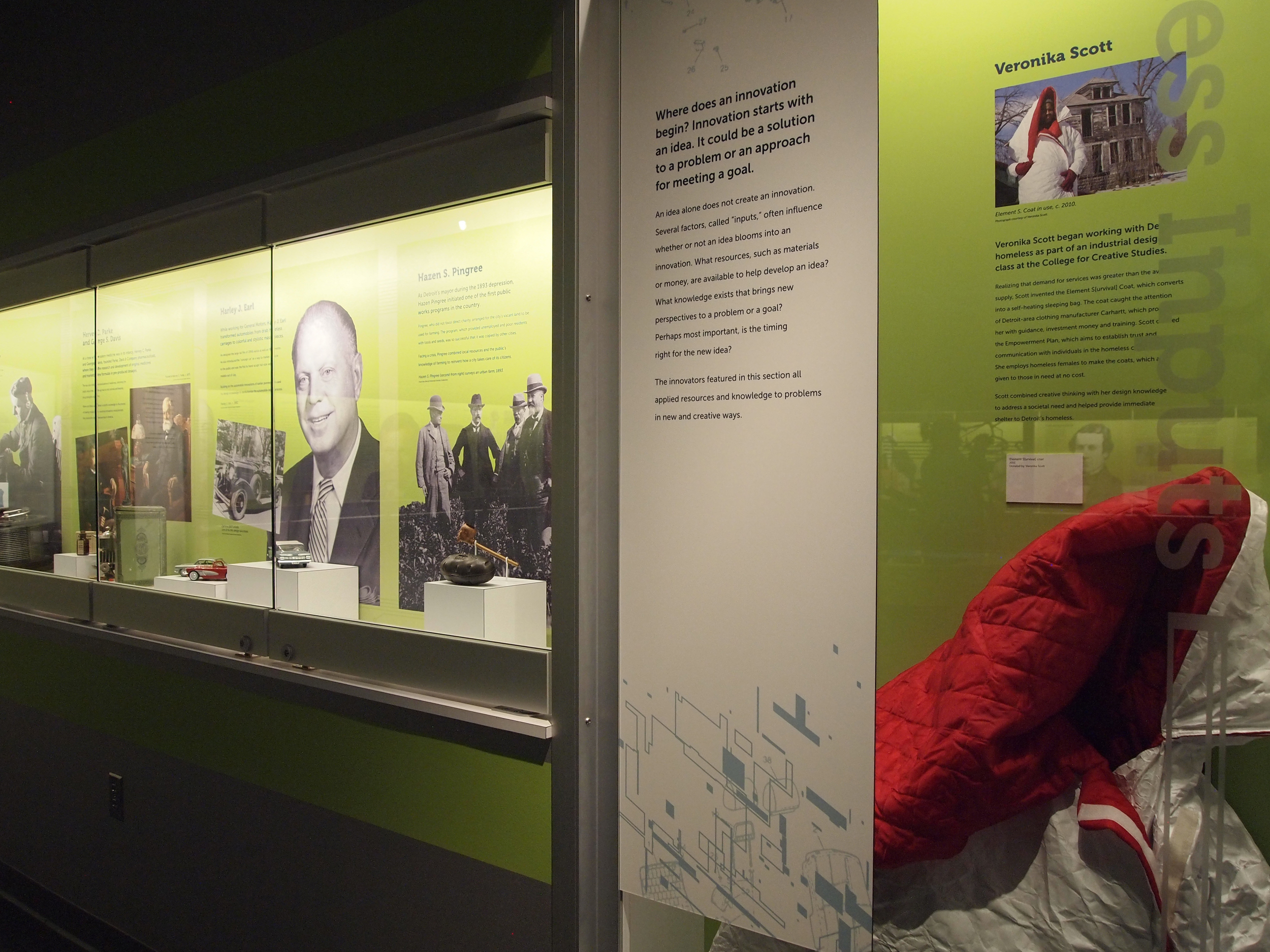
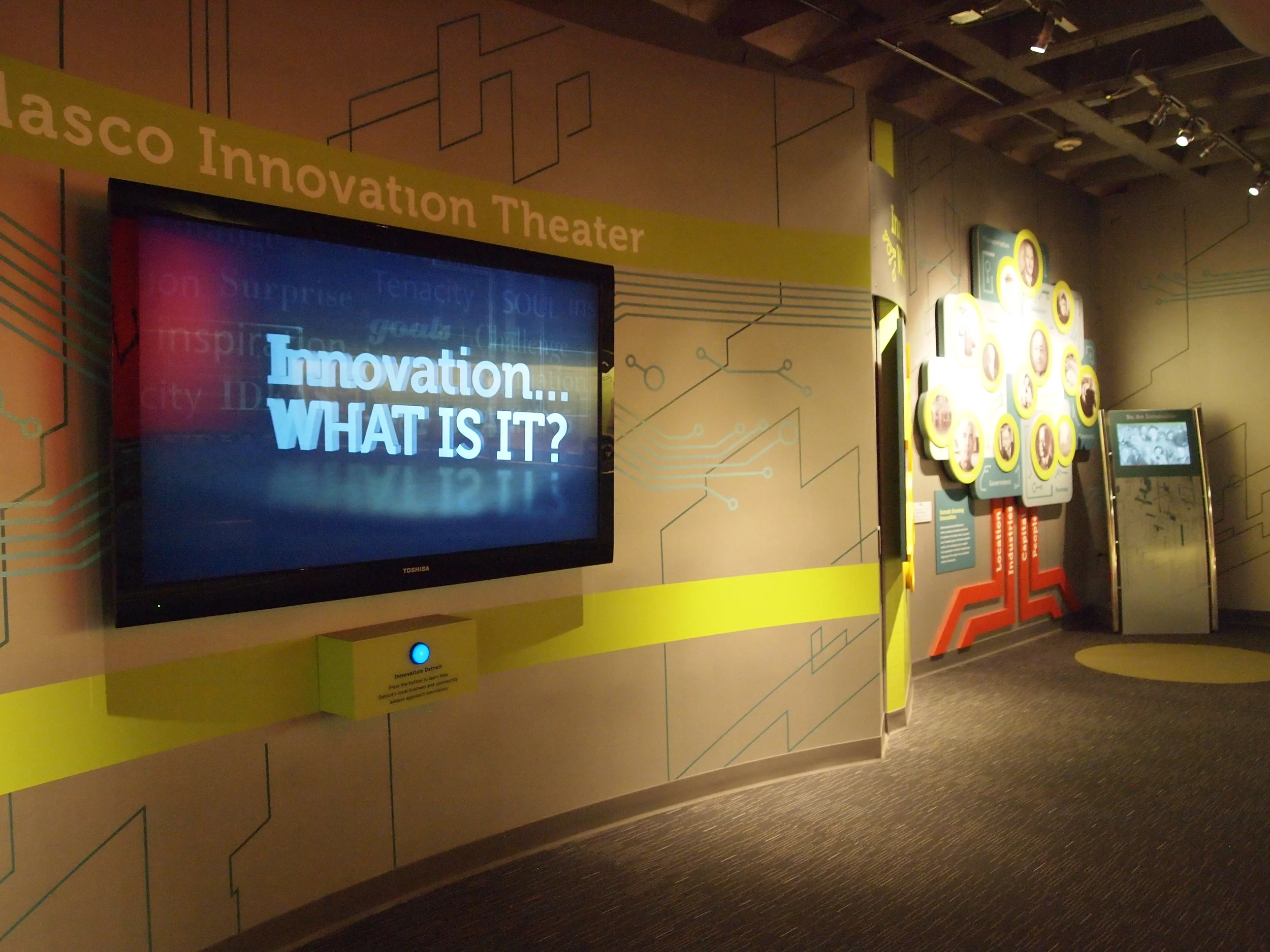
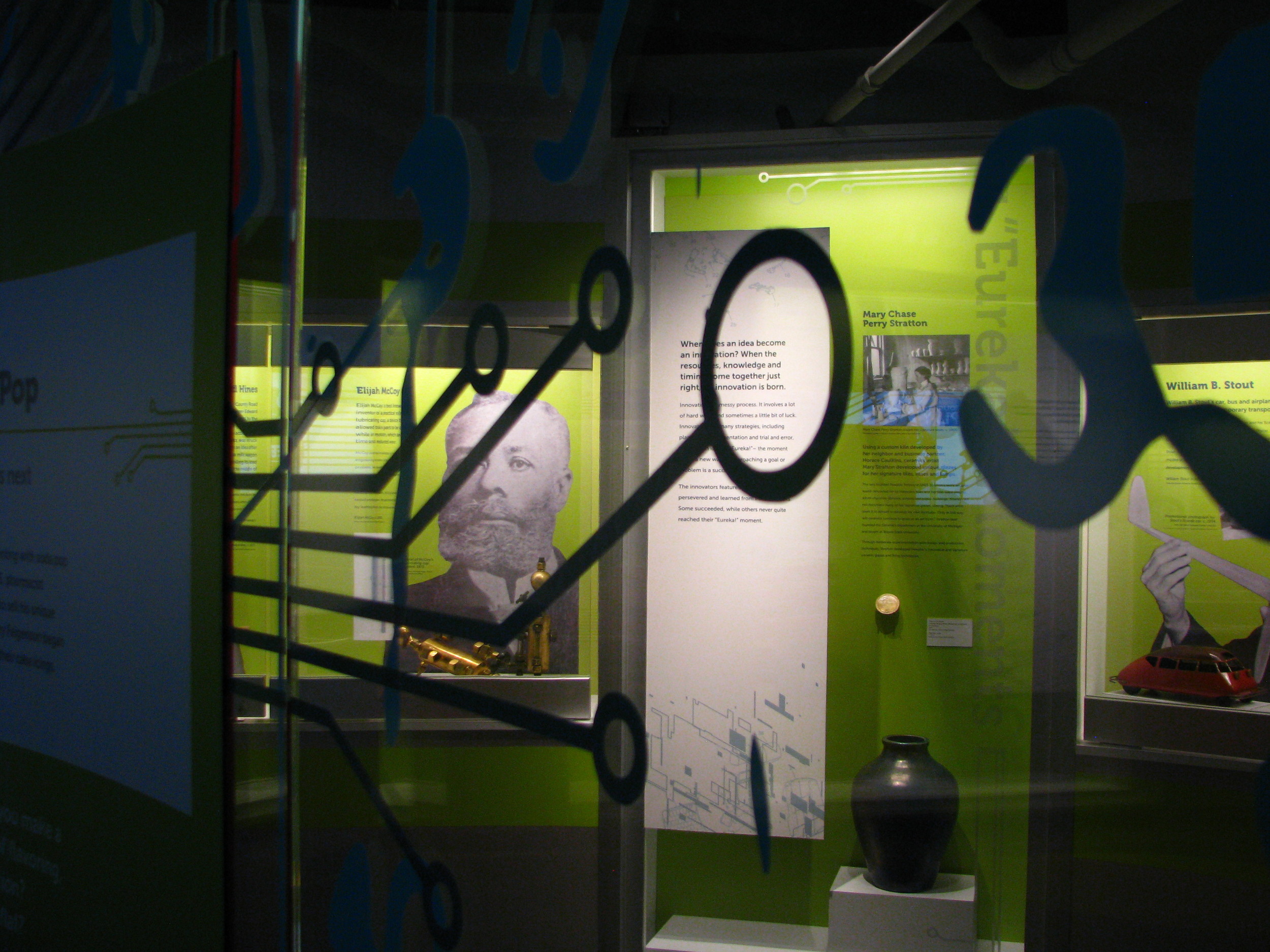
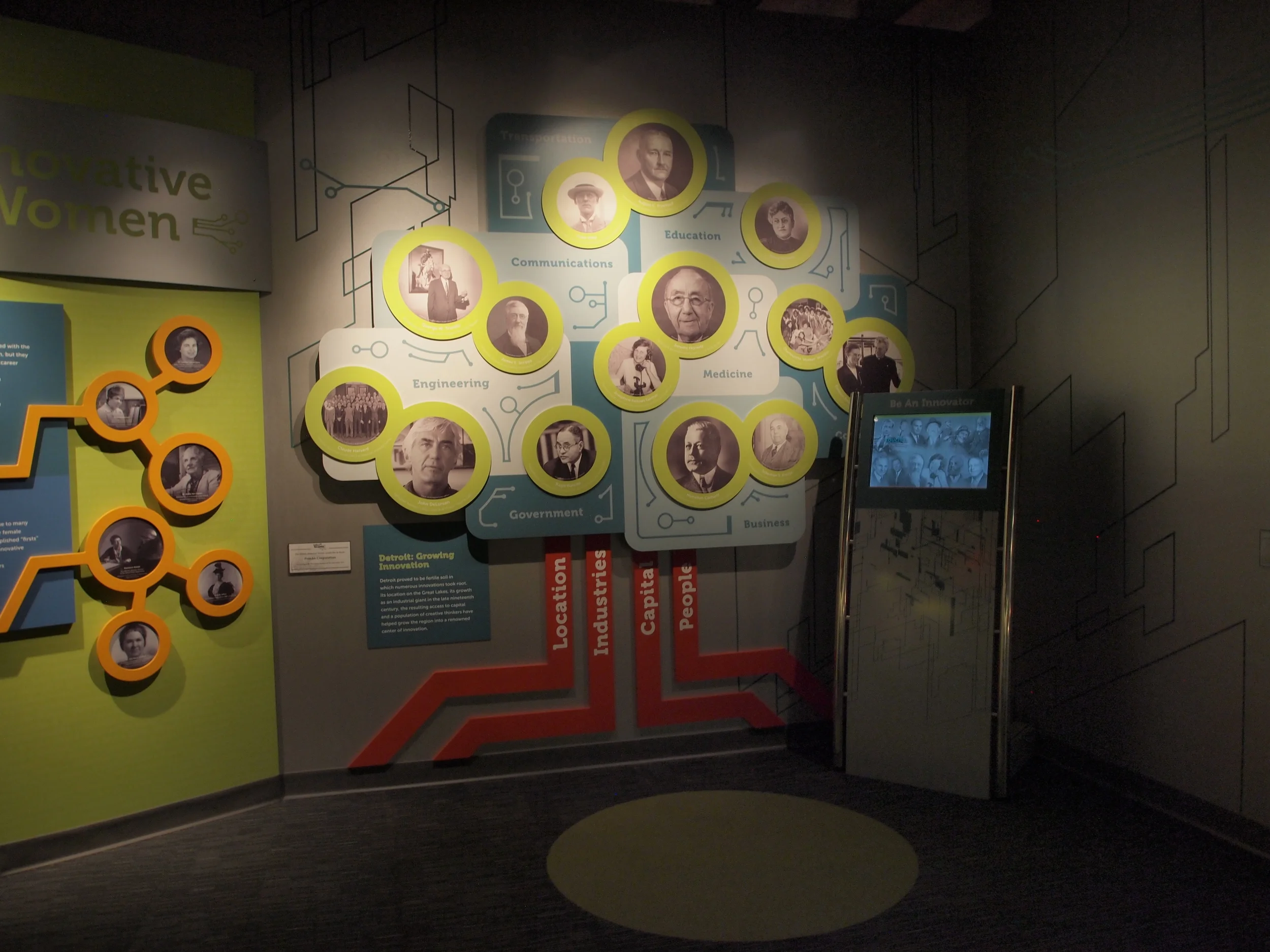
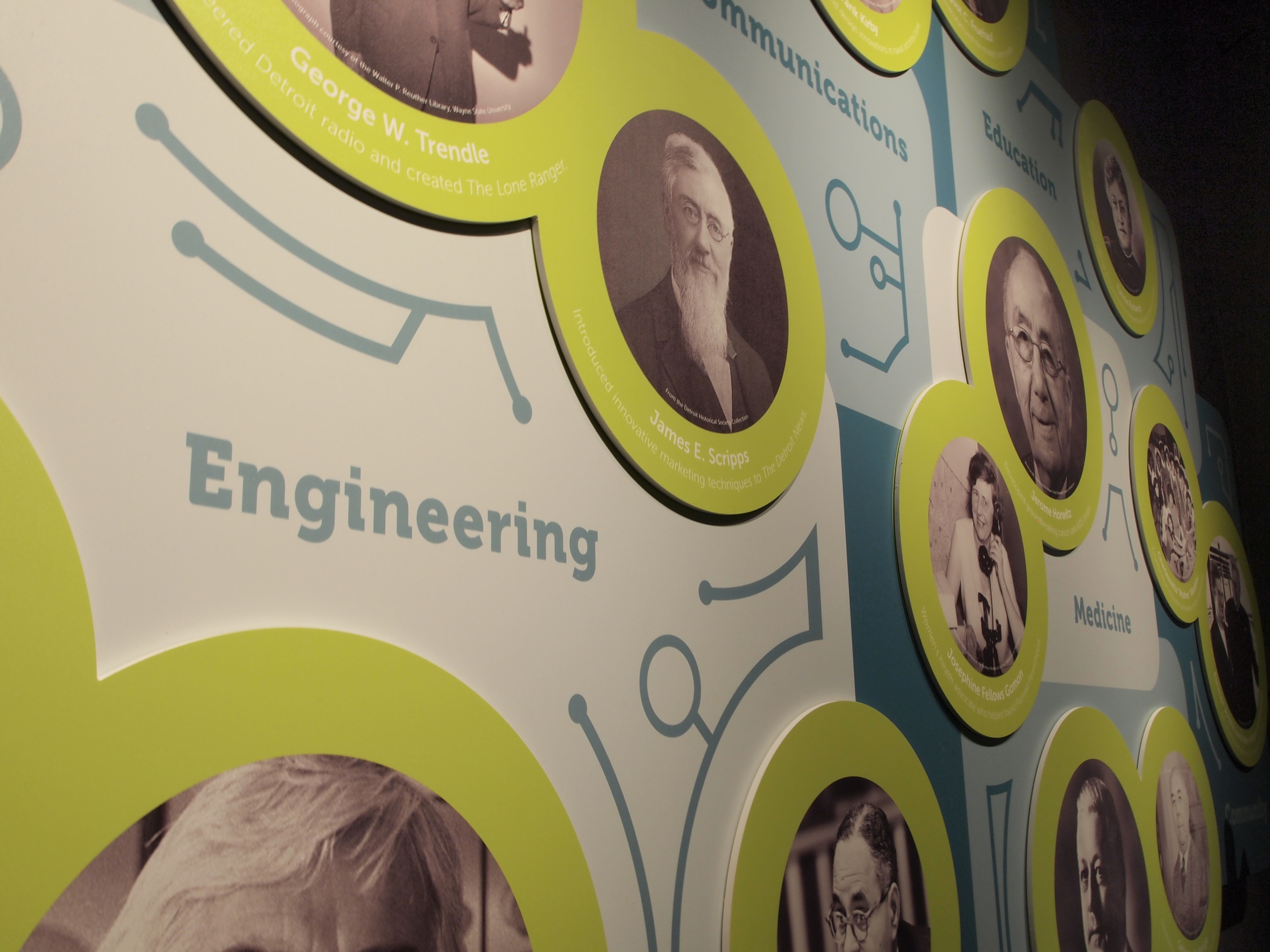

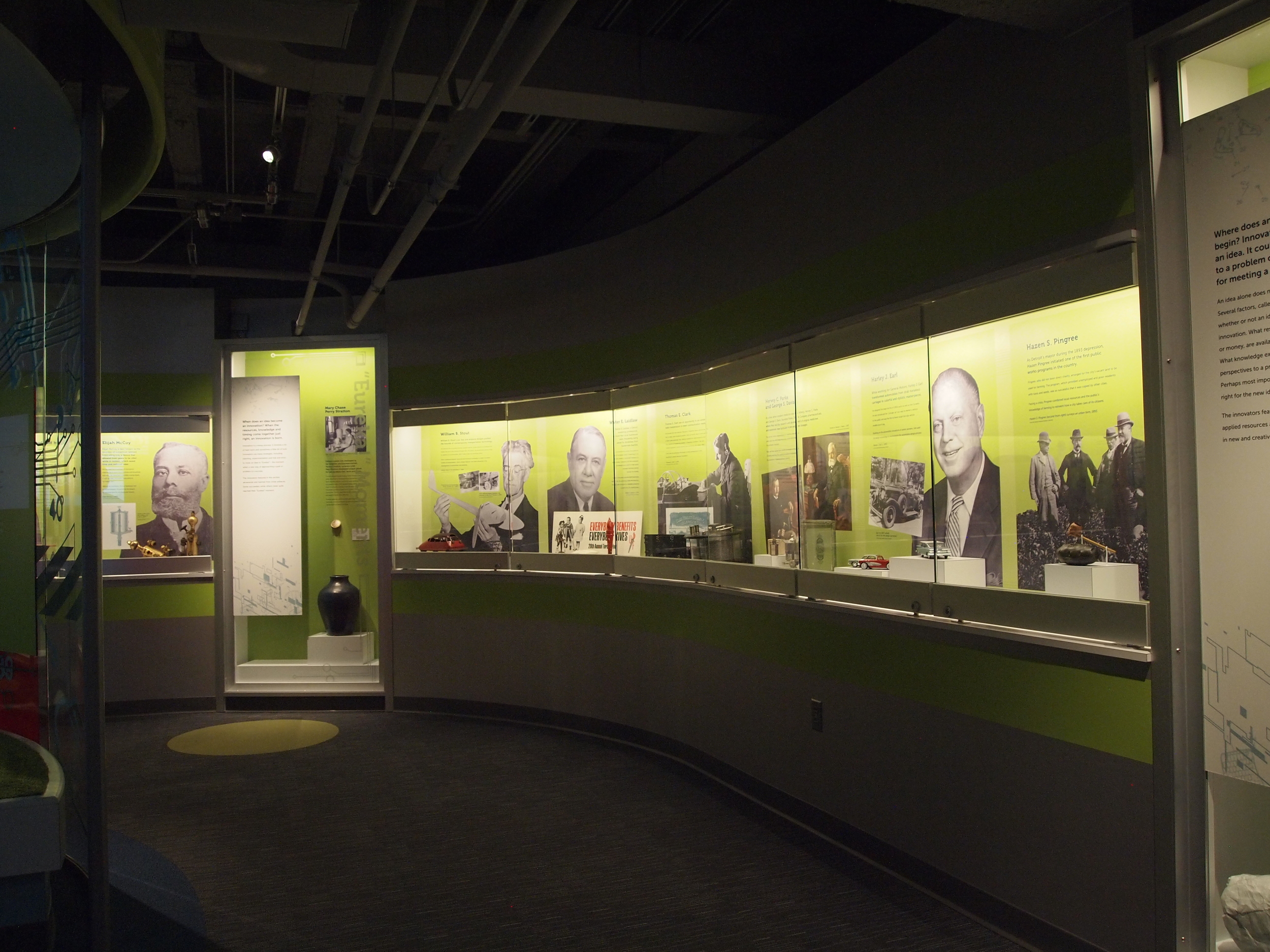
While Detroit may be best known for auto production, the same creativity and entrepreneurial spirit led to many other business innovations.
Did you know Paint-by-number was invented in Detroit? Dan Robbins was creating washable paint sets for kids when he took up the challenge to develop a way to make anyone an artist.
It should come as no surprise that with the city’s manufacturing knowledge and all the miles of Michigan shoreline and inland lakes that Detroiters played a major role in the development of the outboard motor.
Other innovations included some that were auto related – like traffic lane striping – and others that weren’t like Tupperware parties and advancements in industrial architecture.
Innovation Detroit is a gallery dedicated to the innovative people in Detroit’s past and to those working today.
As you might expect, this exhibit features large artifact cases showcasing the inventions of some of Detroit’s most ingenious minds but it’s also interactive. Visitors are invited to try their hand at developing a new product and bringing it to market through a competitive AV interactive installation.
Allesee Gallery of Culture
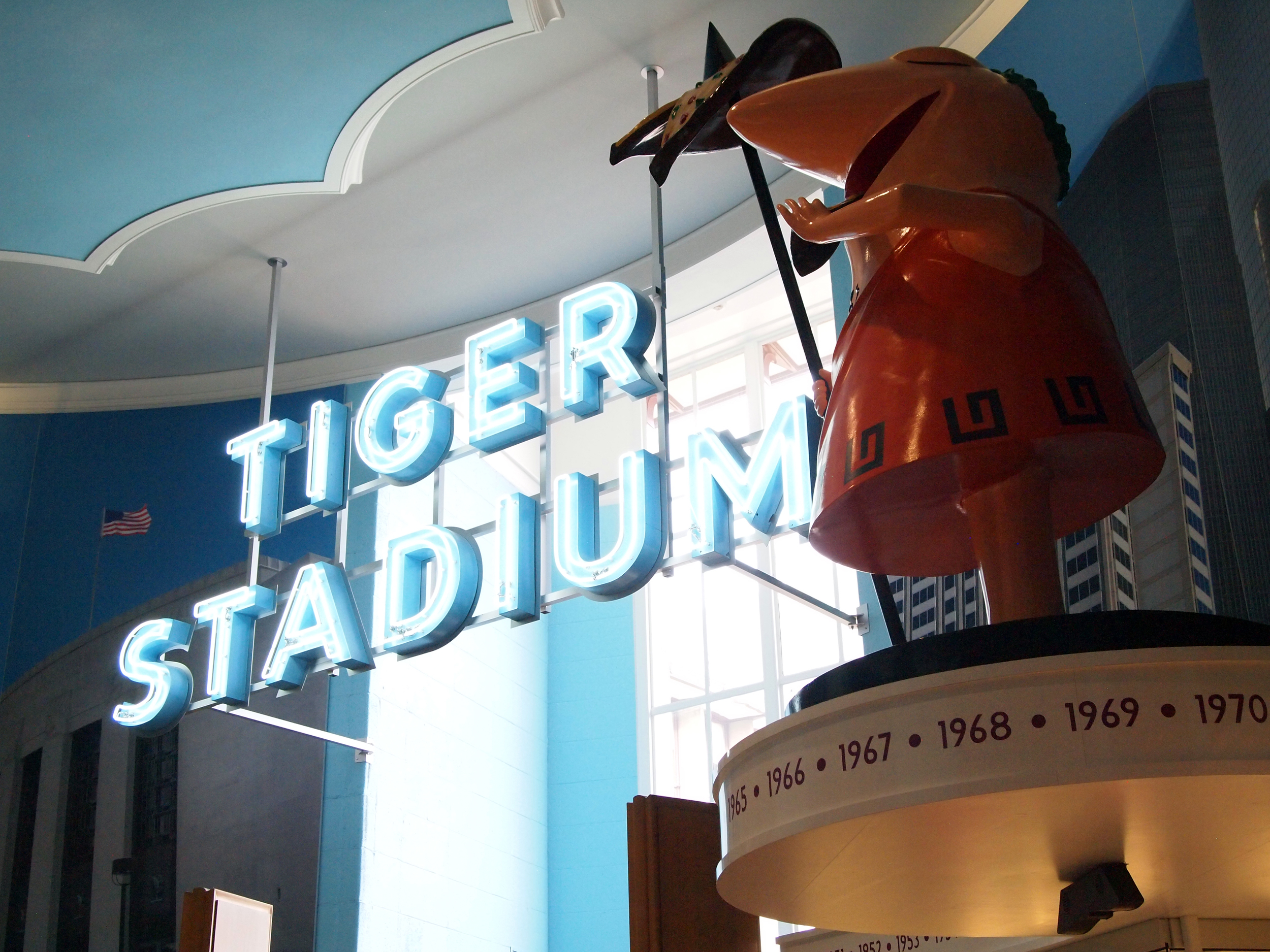
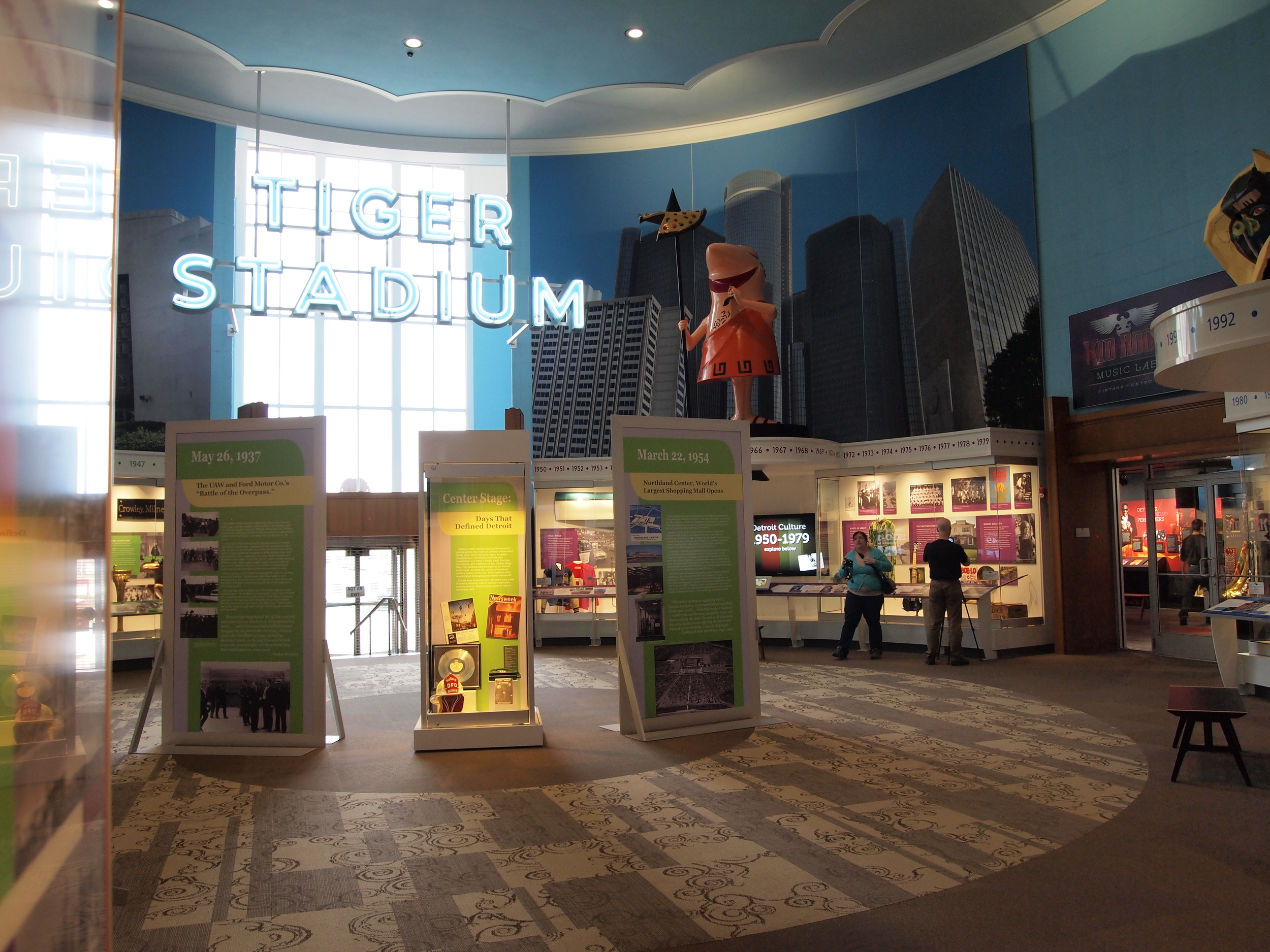

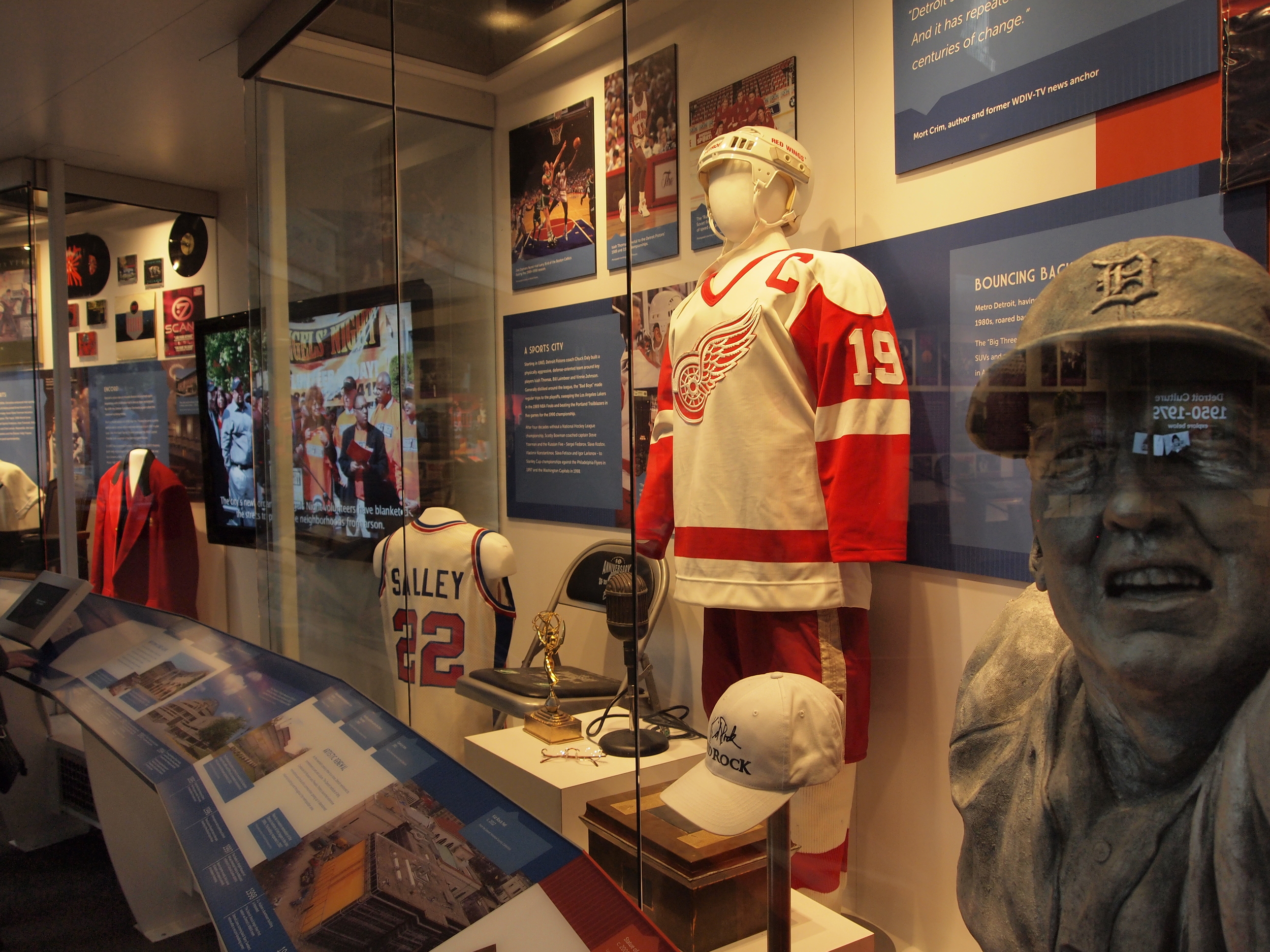
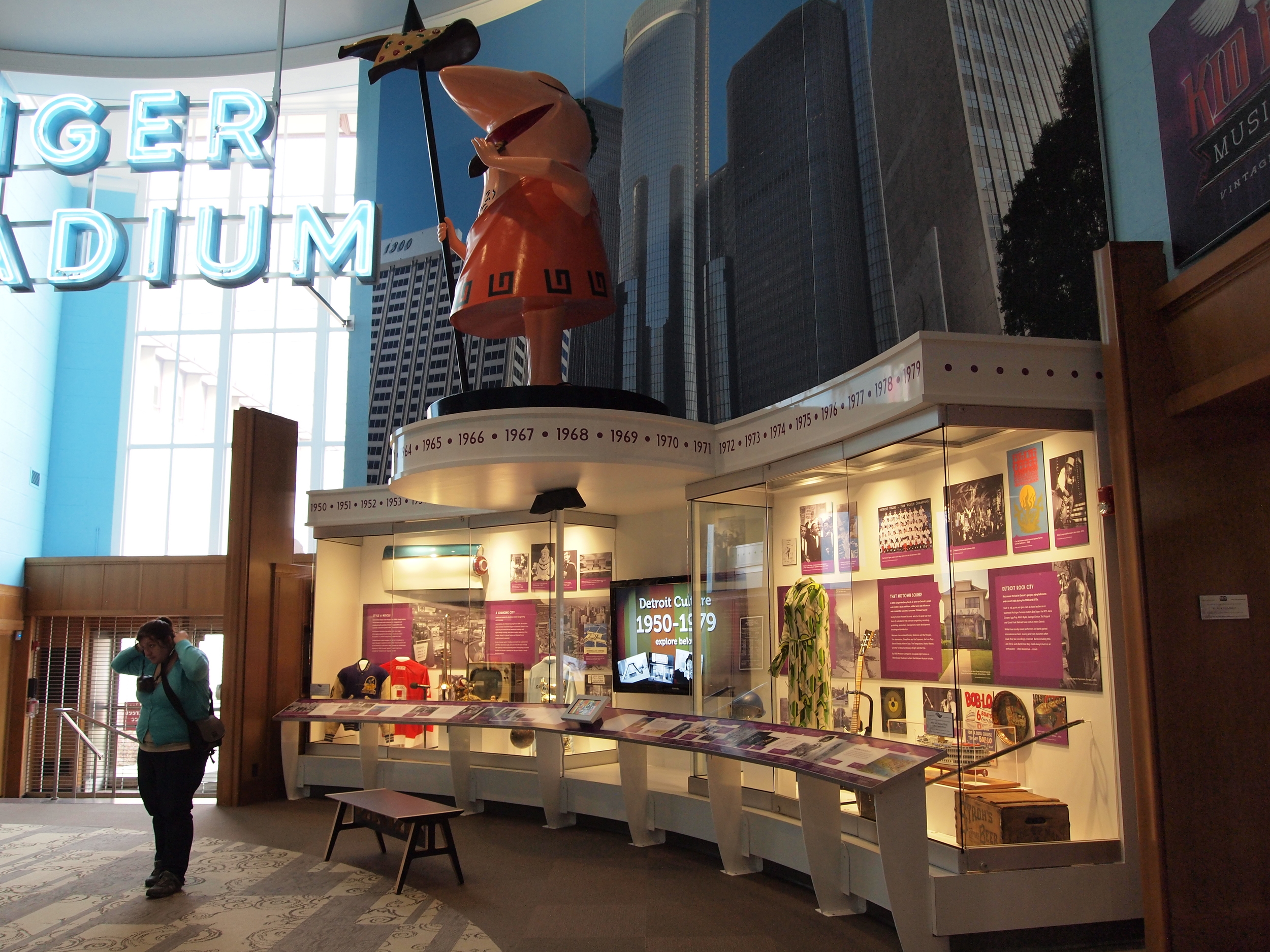
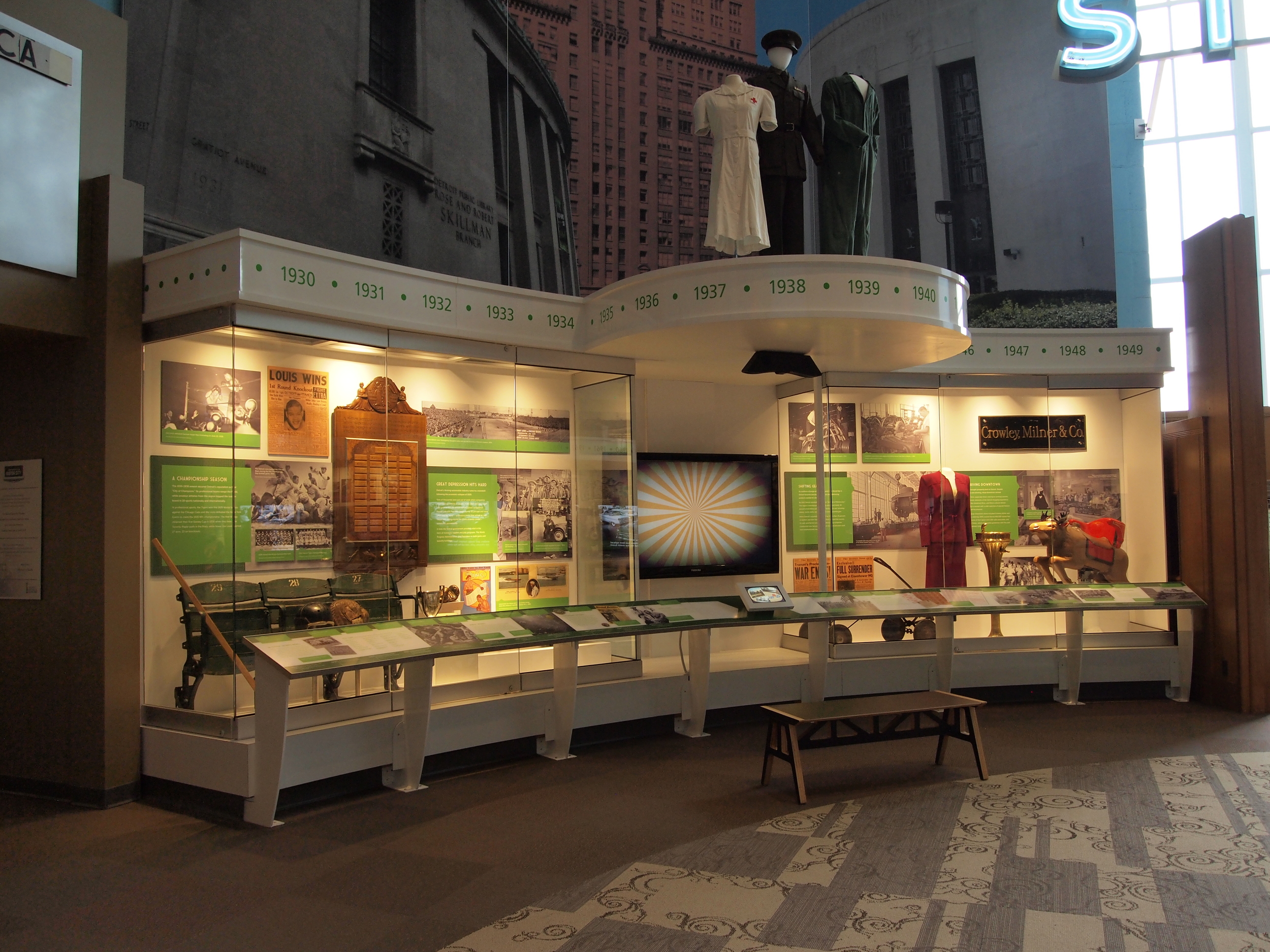
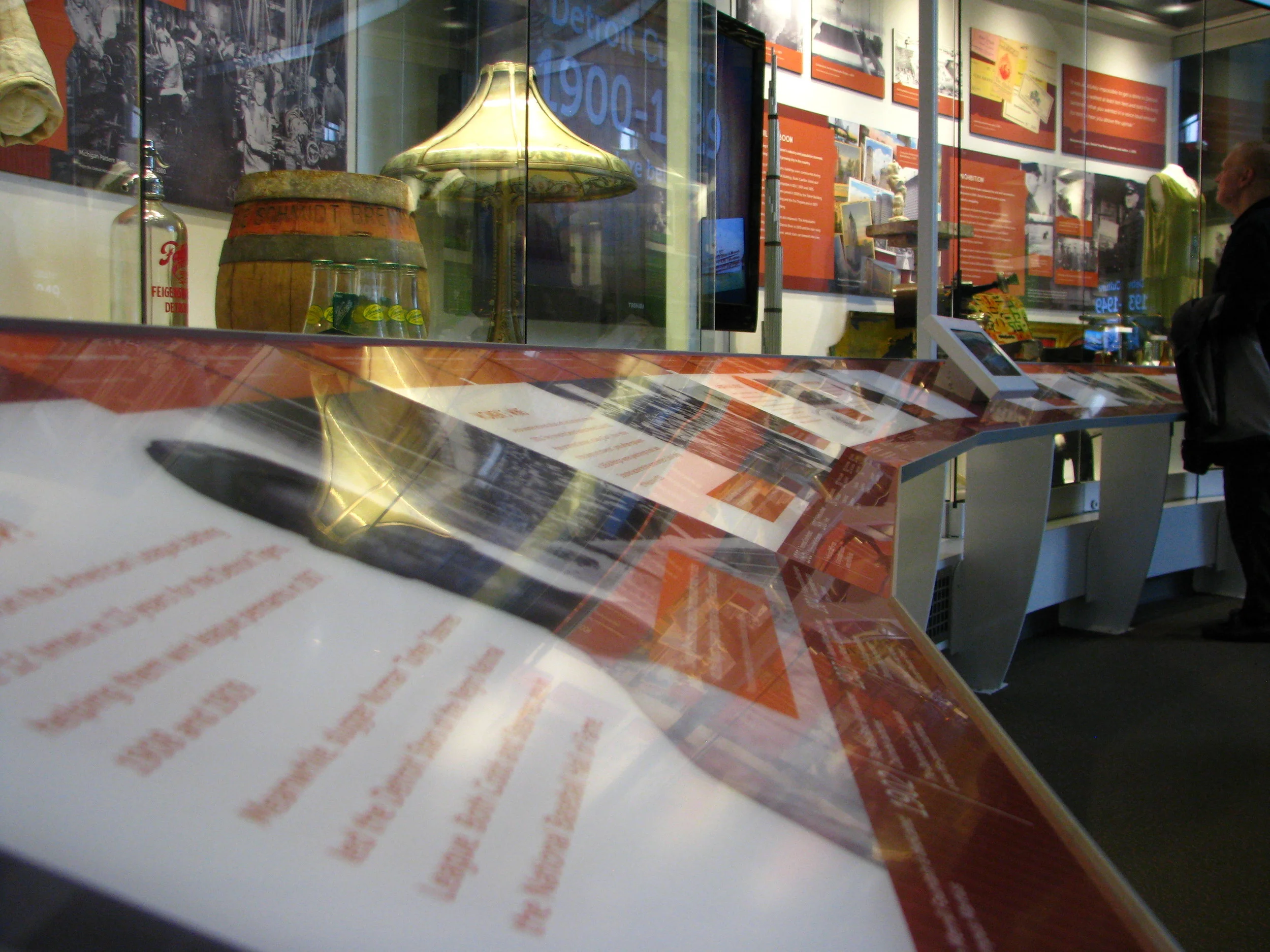
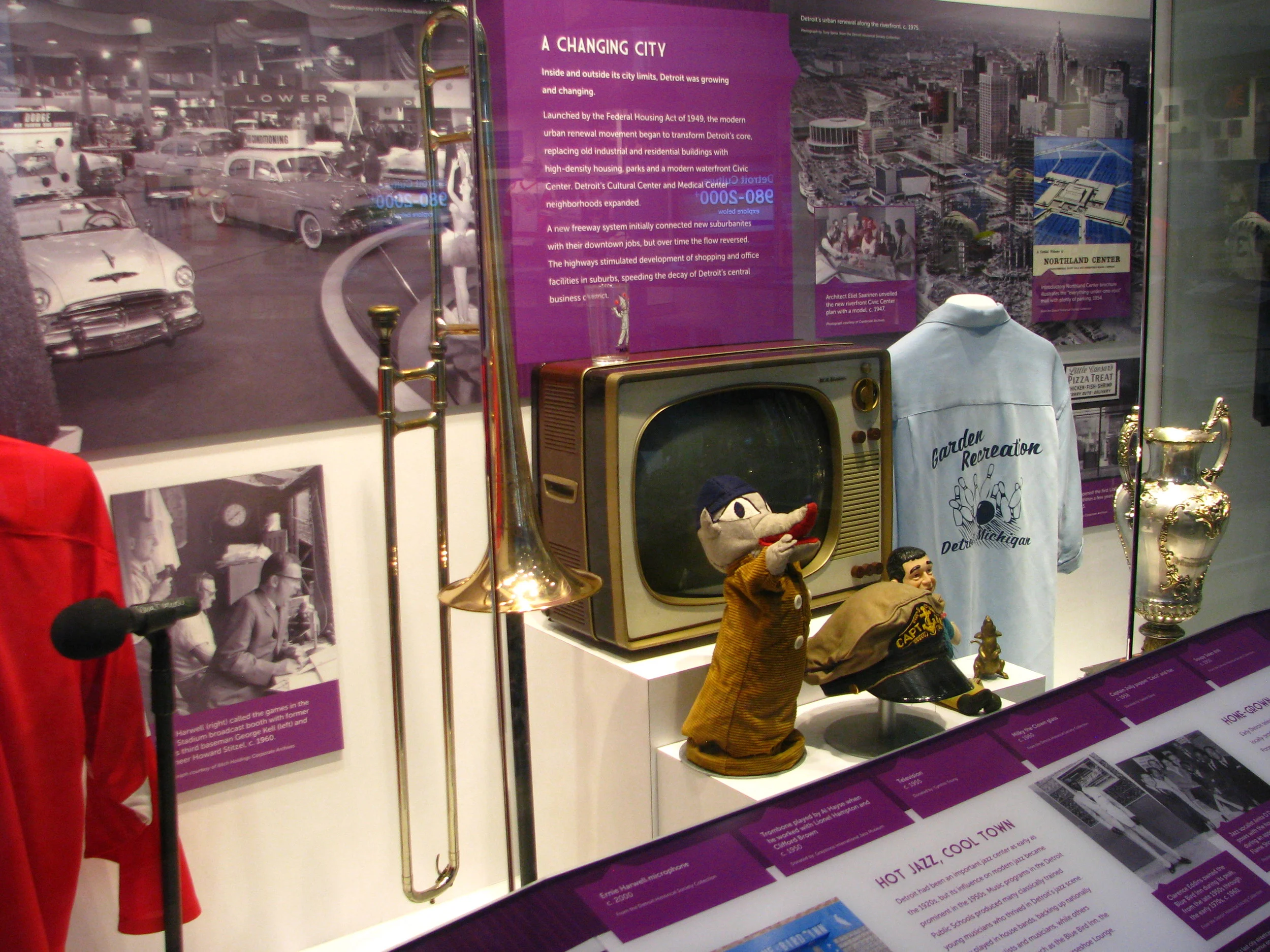
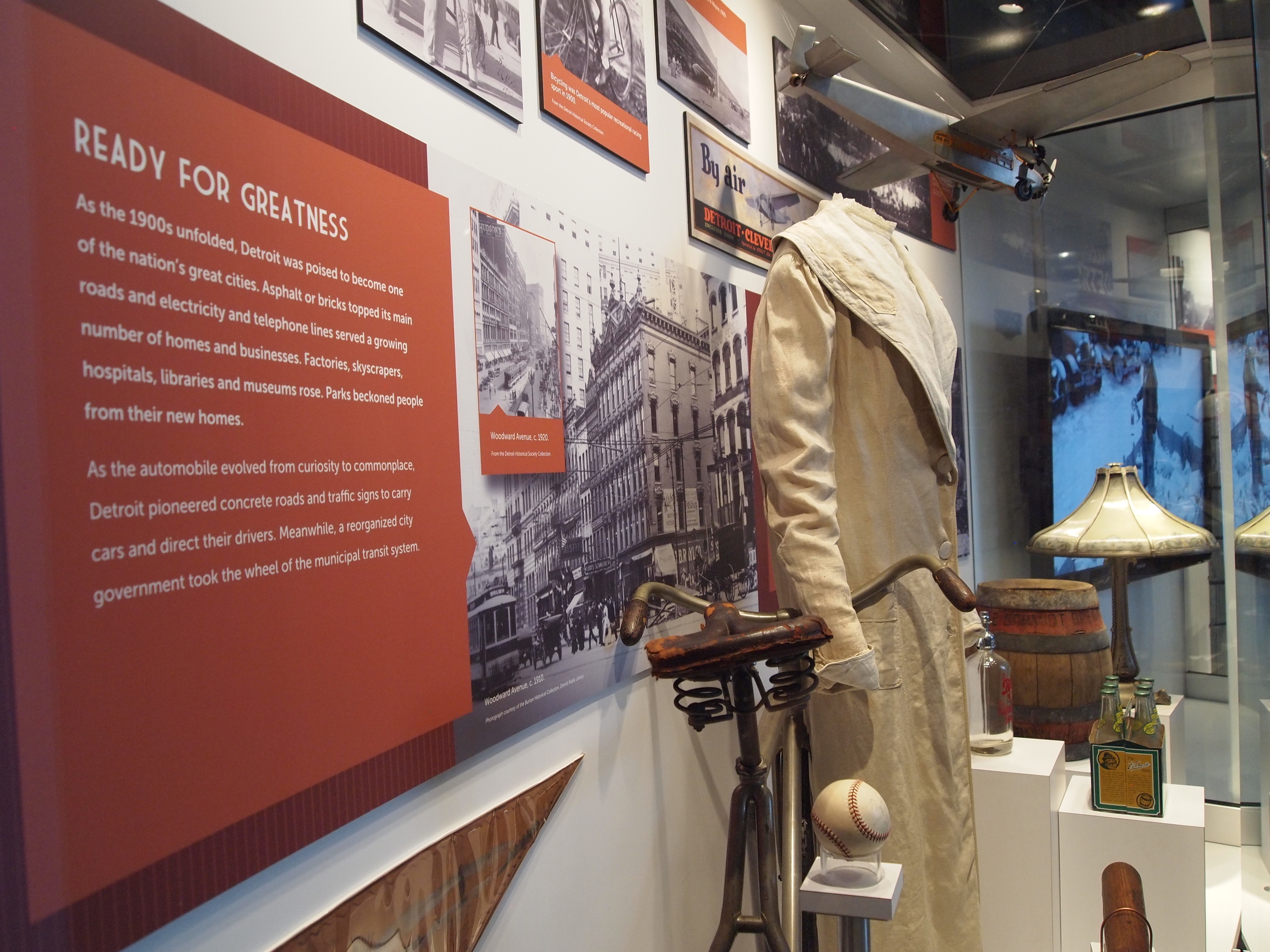
Detroit is a city of culture and cultures and the Allesee Gallery of Culture captures snapshots of Detroit’s history in music, theater, art and architecture, sports and recreation, industry and commerce and through turbulent decades marked by social tensions.
Filled with artifacts, gallery visitors are greeted by the lettering from the façade of Tiger Stadium which has been refurbished and prominently displayed. And, that’s just the beginning. This gallery features objects from Detroit’s sports teams, downtown businesses, the city’s music culture and more.
Gene’s creative vision for this gallery includes a system of graphic treatments for the various artifact cases that allowed the museum to have flexibility in the case layout. In addition, he created a three tier information system for visitors on each case to enrich their educational experience. Museum goers are encouraged to read captions along the top edge of the cases, interpretive text in the exhibit and a timeline of Detroit’s cultural history that runs along each case’s bottom edge.
Doorway to Freedom

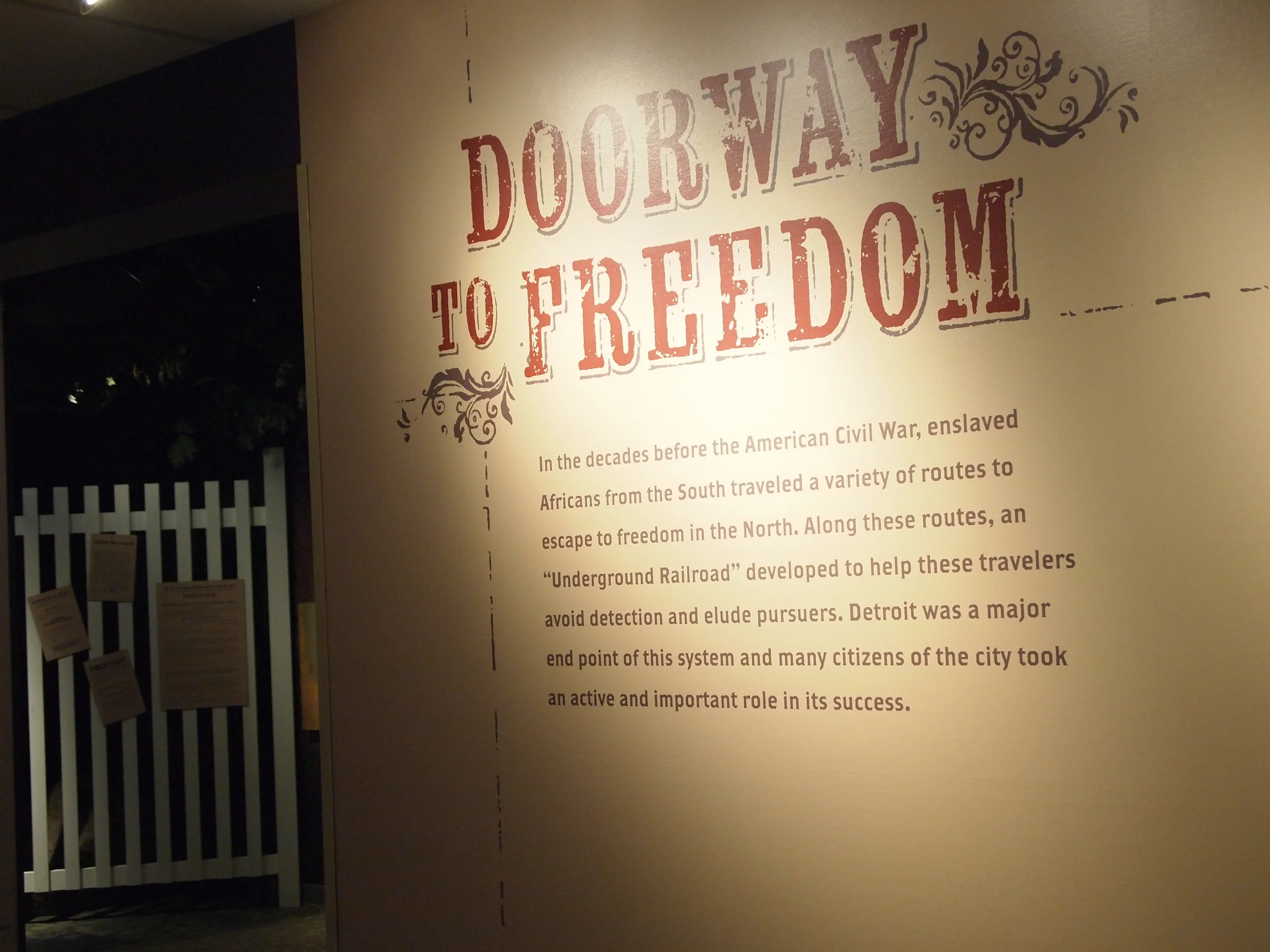
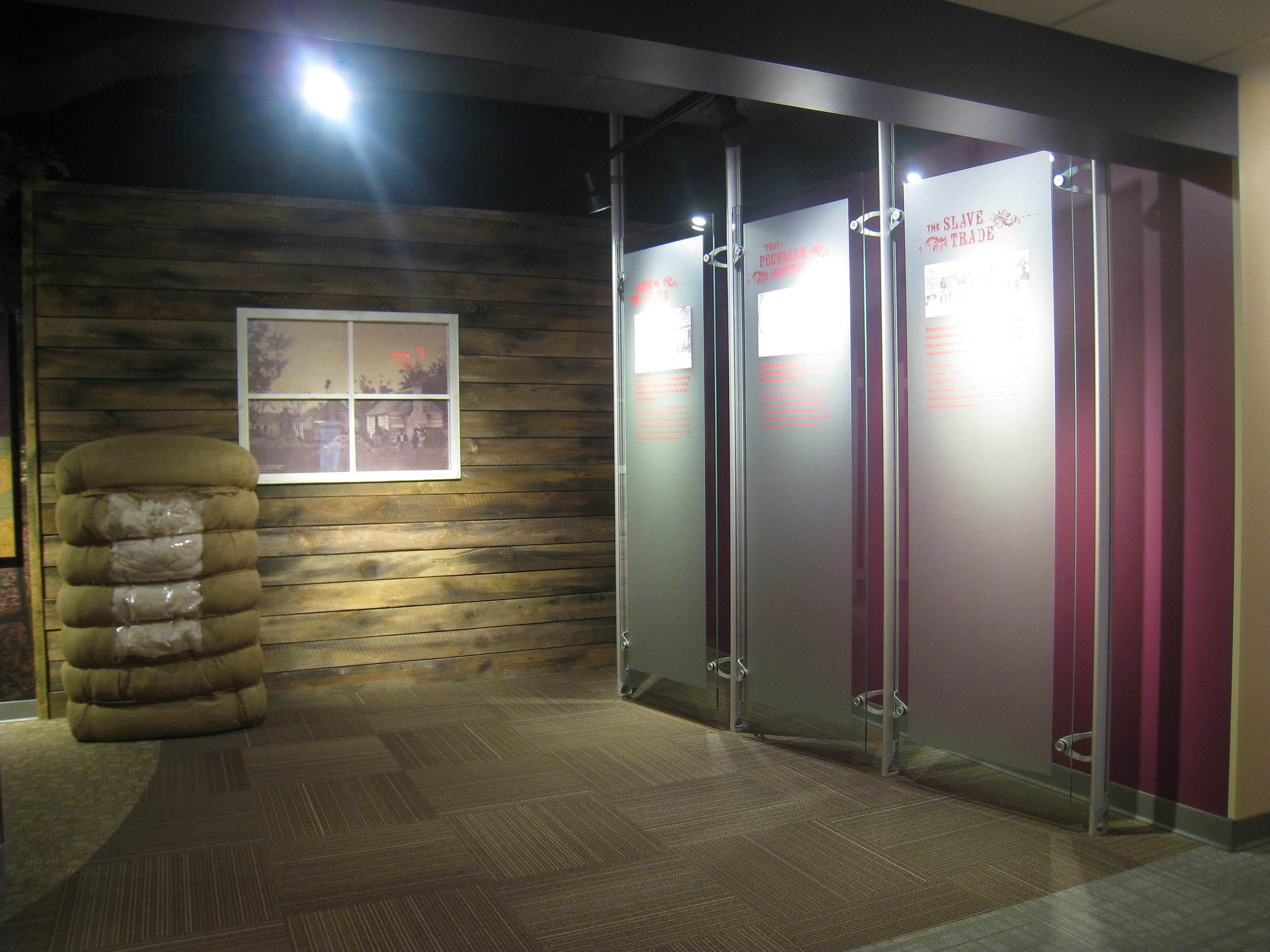

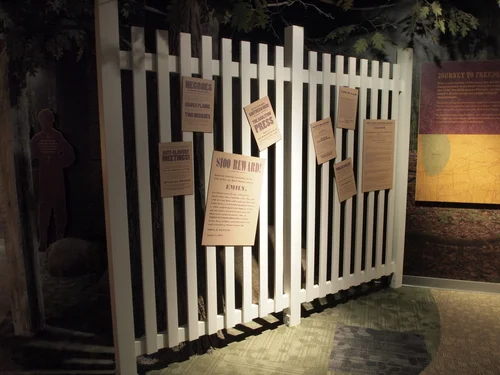
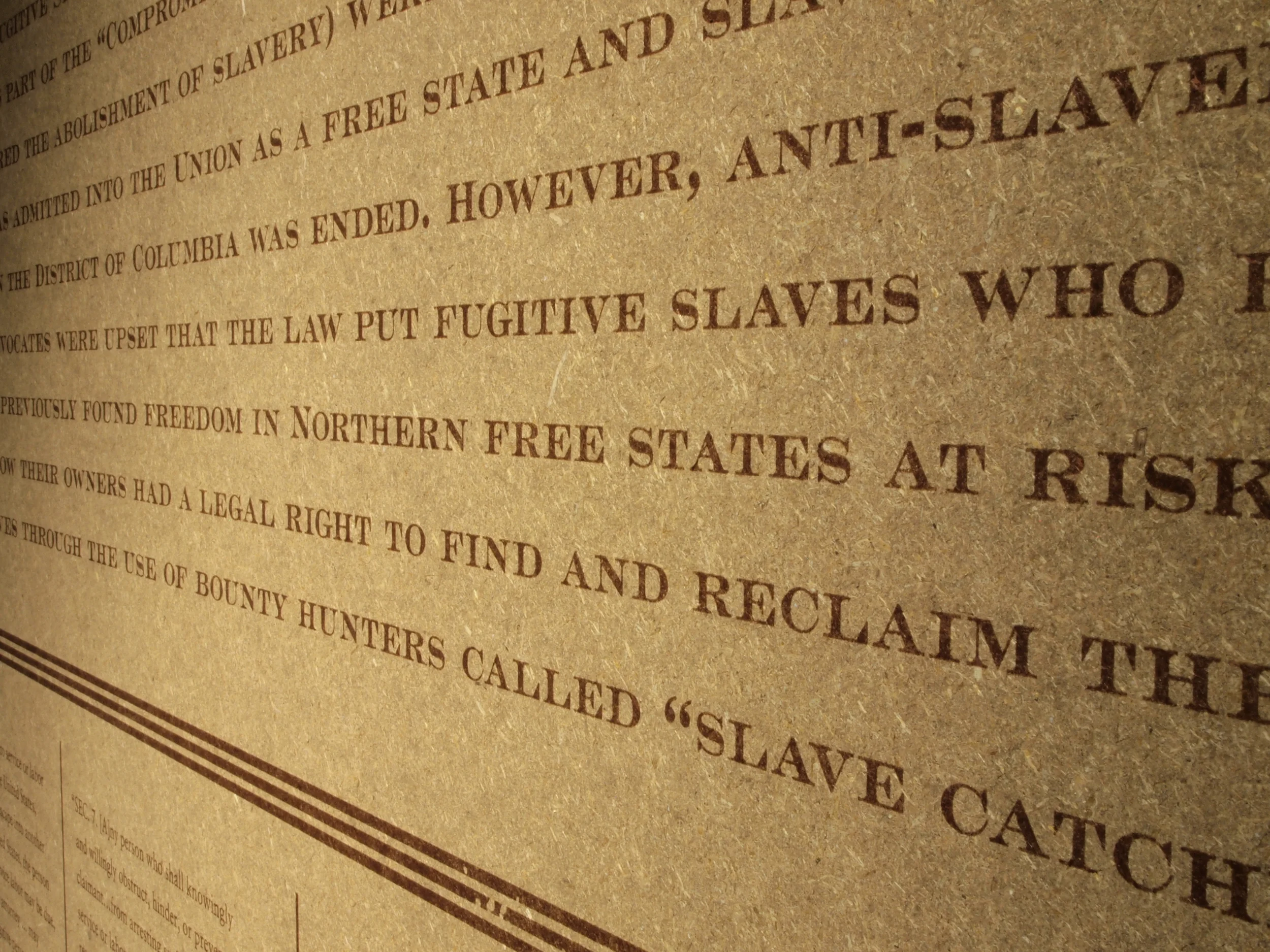

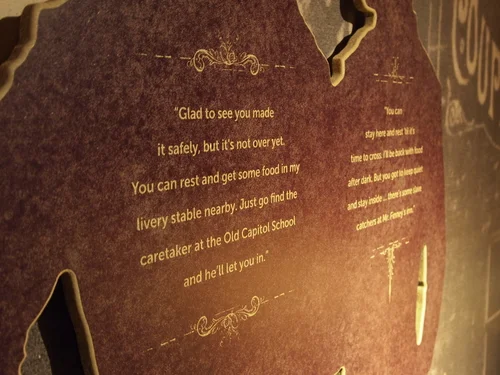
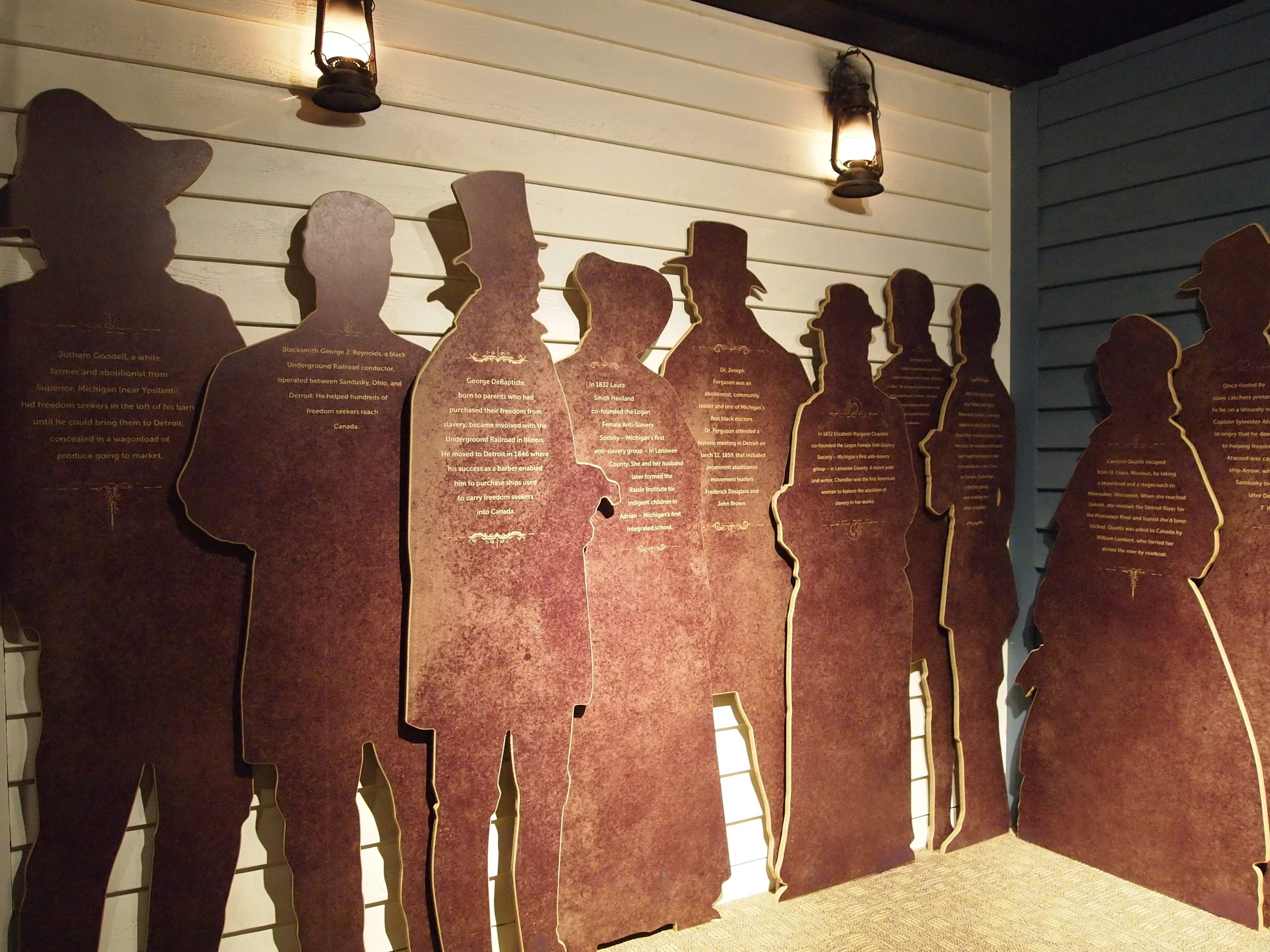


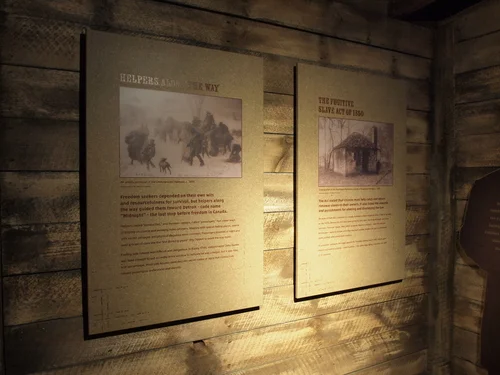

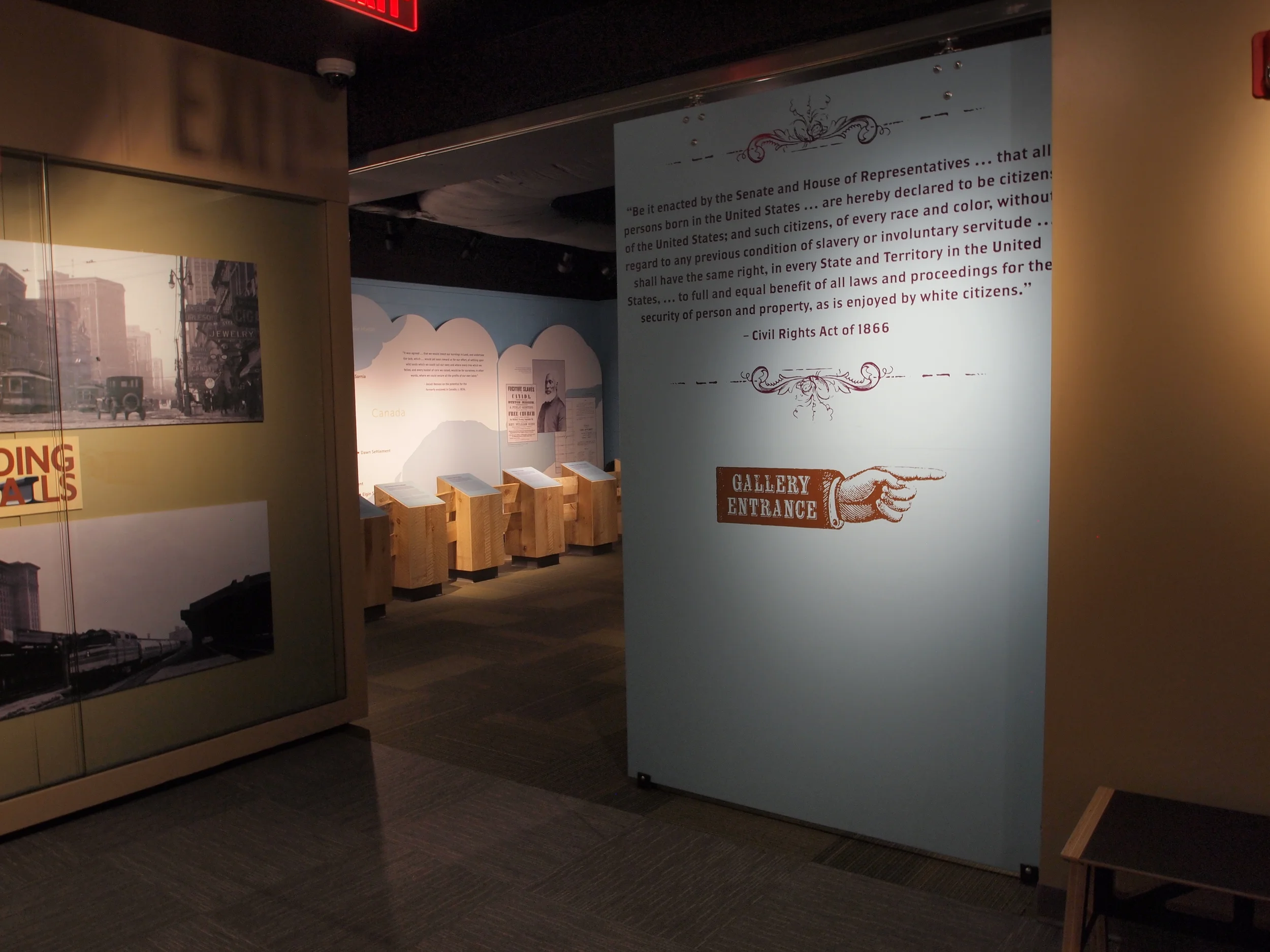

When thinking of Detroit, many people focus on its manufacturing history – its reputation as the “Motor City.” But long before autos were built in Detroit, the city played an important role in a different type of transportation. Detroit was an important stop on the Underground Railroad – the last stop for runaway slaves before crossing the river to Canada – and freedom.
Writer Michael Hodges of the Detroit News commented “Most significant in the makeover is the deep dive the museum now takes into subjects that once got short shrift, notably Detroit’s importance in the Underground Railroad before the Civil War. Once relegated to two glass cases on a stairway landing, ‘Doorway to Freedom’ offers a far more-absorbing, multisensory experience.”
The exhibit is intense… it opens with acapella spirituals. Illustrations include instructions on how to pack slaves into ships sailing from Africa and advertisements about the criminal penalties for anyone who failed to turn in an escaped slave. It’s impossible to view the exhibit and not feel the anxiety and fear that existed for slaves – and for the abolitionists who aided them – during this era of our nation’s history.
Slave stories are told here too. As museum goers walk through the exhibit they’ll hear slaves speak about their experiences and talk about their fears. It’s not until the end of the exhibit that visitors learn which slaves succeeded in gaining their freedom.
In Summary
The Detroit Historical Museum challenge was an exciting and demanding project. As the graphic designer, Gene had to find a way to make the exhibits make sense to patrons of all ages and interests. The graphics must help visitors understand and interpret the exhibits, they must look great and they must educate quickly and effectively.
Museum signage is more than just art. This project required a designer who could use type, color and graphics to evoke the feeling of specific periods of time in the history of Detroit and still unify the look of all the exhibits.
Gene worked closely with authors, researchers, editors and client representatives to make sure his work not only enhanced the visitor experience but also provided solid historical information. And, to make sure that the final product was up to the museum’s high standards, he worked with vendors, exhibit fabricators and the project’s site supervisor to make sure that everything was correctly sized, produced and prepared.
The result? The signage not only enhances the visual appeal of each exhibit, it elevates the visitor experience. Equally important, the work exceeds the Americans with Disabilities Act guidelines, which assures the museum experience can be enjoyed by all.
The success of the Detroit Historical Museum’s renovation, which includes these five new galleries, was reflected in an opening weekend that went for 55 hours straight and garnered compliments and laudatory reviews from individuals and the news media. Once again local media summed it up…
“Always a cool place to visit, the museum reinvented itself as a more interactive experience. Suddenly, there’s a lot more going on.” – The Detroit News
To read the Detroit Free Press article about the opening, click here.
Recognition
Award of Merit, AASLH Leadership in History Awards – excellence in history programs, projects, and people
AASLH bestows Leadership in History Awards to establish and encourage standards of excellence in the collection, preservation, and interpretation of state and local history in order to make the past more meaningful to all Americans. By publicly recognizing superior and innovative achievements, the Leadership in History Awards serve as an inspiration to others in the field.
Exhibit Credits
Graphic Design – Gene Ullery-Smith
Exhibit Planning – Good Design Group
Fabrication – Morley
Project Oversight – David Goodman
Client – Detroit Historical Society

